 |
PERMANENT RULES
Effective Date of Rule: Thirty-one days after filing.
Purpose: This rule:
| ▪ | Changes the designated uses for many rivers from "spawning and noncore rearing" to "core summer salmonid habitat" and changes rule text to support the basis for these changes. This results in many rivers going from a seven-day average temperature of 17.5°C to a seven-day average daily maximum of 16°C and the dissolved oxygen criteria will go from 8.0 mg/l to 9.5 mg/l. |
| ▪ | Changes a small number of rivers to the "char spawning and rearing" designated use type and change rule text to support the basis for these changes. This will result in some rivers going to a seven-day average daily maximum of 12°C from the old daily seven-day average of 16°C or 17.5°C. |
| ▪ | Adds spawning locations and timing windows where explicit spawning/incubation temperature criteria would apply for salmonids. These changes apply a seven-day average daily maximum criterion of 13°C to protect spawning and incubation of salmon and trout (9°C for the spawning of bull trout). |
| ▪ | Correct miscellaneous minor (typographic) errors introduced during the 2003 rule making. |
Citation of Existing Rules Affected by this Order: Amending chapter 173-201A WAC.
Statutory Authority for Adoption: RCW 90.48.035.
Adopted under notice filed as WSR 06-13-104 on June 21, 2006.
Changes Other than Editing from Proposed to Adopted Version: Only corrections, editing, and clarification changes have been made. No changes have been made that alter the substance of the proposed regulation.
A final cost-benefit analysis is available by contacting Melissa Gildersleeve, Department of Ecology, P.O. Box 47600, Olympia, WA 98504-7600, phone (360) 407-6461, fax (360) 407-6426, e-mail mgil461@ecy.wa.gov.
Number of Sections Adopted in Order to Comply with Federal Statute: New 0, Amended 0, Repealed 0; Federal Rules or Standards: New 0, Amended 3, Repealed 0; or Recently Enacted State Statutes: New 0, Amended 0, Repealed 0.
Number of Sections Adopted at Request of a Nongovernmental Entity: New 0, Amended 1, Repealed 0.
Number of Sections Adopted on the Agency's Own Initiative: New 0, Amended 1, Repealed 0.
Number of Sections Adopted in Order to Clarify, Streamline, or Reform Agency Procedures: New 0, Amended 1, Repealed 0.
Number of Sections Adopted Using Negotiated Rule Making: New 0, Amended 0, Repealed 0; Pilot Rule Making: New 0, Amended 0, Repealed 0; or Other Alternative Rule Making: New 0, Amended 0, Repealed 0.
Date Adopted: November 20, 2006.
Jay J. Manning
Director
OTS-8928.5
AMENDATORY SECTION(Amending Order 02-14, filed 7/1/03,
effective 8/1/03)
WAC 173-201A-200
Fresh water designated uses and
criteria.
The following uses are designated for protection in
fresh surface waters of the state. Use designations for water
bodies are listed in WAC 173-201A-600 and 173-201A-602.
(1) Aquatic life uses. Aquatic life uses are designated
((using the following categories of key species)) based on the
presence of, or the intent to provide protection for, the key
uses identified in (a) of this subsection. It is required
that all indigenous fish and nonfish aquatic species be
protected in waters of the state in addition to the key
species described below.
(a) The categories for aquatic life uses are:
(i) Char((. For the protection of spawning and early
tributary rearing (e.g., first year juveniles) of native char
(bull trout and Dolly Varden), and other associated aquatic
life.
(ii) Salmon and trout spawning, core rearing, and migration. For the protection of spawning, core rearing, and migration of salmon and trout, and other associated aquatic life.
(iii) Salmon and trout spawning, noncore rearing, and migration. For the protection of spawning, noncore rearing, and migration of salmon and trout, and other associated aquatic life.
(iv) Salmon and trout rearing and migration only. For the protection of rearing and migration of salmon and trout, and other associated aquatic life.)) spawning and rearing. The key identifying characteristics of this use are spawning or early juvenile rearing by native char (bull trout and Dolly Varden), or use by other aquatic species similarly dependent on such cold water. Other common characteristic aquatic life uses for waters in this category include summer foraging and migration of native char; and spawning, rearing, and migration by other salmonid species.
(ii) Core summer salmonid habitat. The key identifying characteristics of this use are summer (June 15 - September 15) salmonid spawning or emergence, or adult holding; use as important summer rearing habitat by one or more salmonids; or foraging by adult and subadult native char. Other common characteristic aquatic life uses for waters in this category include spawning outside of the summer season, rearing, and migration by salmonids.
(iii) Salmonid spawning, rearing, and migration. The key identifying characteristic of this use is salmon or trout spawning and emergence that only occurs outside of the summer season (September 16 - June 14). Other common characteristic aquatic life uses for waters in this category include rearing and migration by salmonids.
(iv) Salmonid rearing and migration only. The key identifying characteristic of this use is use only for rearing or migration by salmonids (not used for spawning).
(v) Non-anadromous interior redband trout. For the protection of waters where the only trout species is a non-anadromous form of self-reproducing interior redband trout (O. mykis), and other associated aquatic life.
(vi) Indigenous warm water species. For the protection of waters where the dominant species under natural conditions would be temperature tolerant indigenous nonsalmonid species. Examples include dace, redside shiner, chiselmouth, sucker, and northern pikeminnow.
(b) General criteria. General criteria that apply to all aquatic life fresh water uses are described in WAC 173-201A-260 (2)(a) and (b), and are for:
(i) Toxic, radioactive, and deleterious materials; and
(ii) Aesthetic values.
(c) Aquatic life temperature criteria. Except where noted, water temperature is measured by the 7-day average of the daily maximum temperatures (7-DADMax). Table 200 (1)(c) lists the temperature criteria for each of the aquatic life use categories.
Table 200 (1)(c)
Aquatic Life Temperature Criteria in Fresh Water
| Category | Highest 7-DADMax |
| Char Spawning | 9°C (48.2°F) |
| Char Spawning and Rearing | 12°C (53.6°F) |
| Salmon and Trout Spawning | 13°C (55.4°F) |
| (( |
16°C (60.8°F) |
| (( |
17.5°C (63.5°F) |
| (( |
17.5°C (63.5°F) |
| Non-anadromous Interior Redband Trout | 18°C (64.4°F) |
| Indigenous Warm Water Species | 20°C (68°F) |
(i) When a water body's temperature is warmer than the criteria in Table 200 (1)(c) (or within 0.3°C (0.54°F) of the criteria) and that condition is due to natural conditions, then human actions considered cumulatively may not cause the 7-DADMax temperature of that water body to increase more than 0.3°C (0.54°F).
(ii) When the ((natural)) background condition of the
water is cooler than the criteria in Table 200 (1)(c), the
allowable rate of warming up to, but not exceeding, the
numeric criteria from human actions is restricted as follows:
(A) Incremental temperature increases resulting from
individual point source activities must not, at any time,
exceed ((28/(T+5))) 28/(T+7) as measured at the edge of a
mixing zone boundary (where "T" represents the background
temperature as measured at a point or points unaffected by the
discharge and representative of the highest ambient water
temperature in the vicinity of the discharge); and
(B) Incremental temperature increases resulting from the combined effect of all nonpoint source activities in the water body must not, at any time, exceed 2.8°C (5.04°F).
(iii) Temperatures are not to exceed the criteria at a probability frequency of more than once every ten years on average.
(iv) Spawning and incubation protection. ((Where the
department determines the temperature criteria established for
a water body would likely not result in protective spawning
and incubation temperatures, the following criteria apply:))
The department has identified waterbodies, or portions
thereof, which require special protection for spawning and
incubation in ecology publication 06-10-038 (also available on
ecology's web site at www.ecy.wa.gov). This publication
indicates where and when the following criteria are to be
applied to protect the reproduction of native char, salmon,
and trout:
• Maximum 7-DADMax temperatures of 9°C (48.2°F) at the initiation of spawning and at fry emergence for char; and
• Maximum 7-DADMax temperatures of 13°C (55.4°F) at the initiation of spawning for salmon and at fry emergence for salmon and trout.
The two criteria above are protective of incubation as
long as human actions do not significantly disrupt the normal
patterns of fall cooling and spring warming that provide
significantly colder temperatures over the majority of the
incubation period. ((The department will maintain a list of
waters where the single-summer maximum criterion is not
sufficient to protect spawning and incubation.))
(v) For lakes, human actions considered cumulatively may not increase the 7-DADMax temperature more than 0.3°C (0.54°F) above natural conditions.
(vi) Temperature measurements should be taken to represent the dominant aquatic habitat of the monitoring site. This typically means samples should:
(A) Be taken from well mixed portions of rivers and streams; and
(B) Not be taken from shallow stagnant backwater areas, within isolated thermal refuges, at the surface, or at the water's edge.
(vii) The department will incorporate the following guidelines on preventing acute lethality and barriers to migration of salmonids into determinations of compliance with the narrative requirements for use protection established in this chapter (e.g., WAC 173-201A-310(1), 173-201A-400(4), and 173-201A-410 (1)(c)). The following site-level considerations do not, however, override the temperature criteria established for waters in subsection (1)(c) of this section or WAC 173-201A-602:
(A) Moderately acclimated (16-20°C, or 60.8-68°F) adult and juvenile salmonids will generally be protected from acute lethality by discrete human actions maintaining the 7-DADMax temperature at or below 22°C (71.6°F) and the 1-day maximum (1-DMax) temperature at or below 23°C (73.4°F).
(B) Lethality to developing fish embryos can be expected to occur at a 1-DMax temperature greater than 17.5°C (63.5°F).
(C) To protect aquatic organisms, discharge plume temperatures must be maintained such that fish could not be entrained (based on plume time of travel) for more than two seconds at temperatures above 33°C (91.4°F) to avoid creating areas that will cause near instantaneous lethality.
(D) Barriers to adult salmonid migration are assumed to exist any time the 1-DMax temperature is greater than 22°C (71.6°F) and the adjacent downstream water temperatures are 3°C (5.4°F) or more cooler.
(viii) Nothing in this chapter shall be interpreted to prohibit the establishment of effluent limitations for the control of the thermal component of any discharge in accordance with 33 U.S.C. 1326 (commonly known as section 316 of the Clean Water Act).
(d) Aquatic life dissolved oxygen (D.O.) criteria. The D.O. criteria are measured in milligrams per liter (mg/L). Table 200 (1)(d) lists the 1-day minimum D.O. for each of the aquatic life use categories.
Table 200 (1)(d)
Aquatic Life Dissolved Oxygen Criteria in Fresh Water
| Category | Lowest 1-Day Minimum |
| Char Spawning and Rearing | 9.5 mg/L |
| (( |
9.5 mg/L |
| (( |
8.0 mg/L |
| (( |
6.5 mg/L |
| Non-anadromous Interior Redband Trout | 8.0 mg/L |
| Indigenous Warm Water Species | 6.5 mg/L |
(ii) For lakes, human actions considered cumulatively may not decrease the dissolved oxygen concentration more than 0.2 mg/L below natural conditions.
(iii) Concentrations of D.O. are not to fall below the criteria in the table at a probability frequency of more than once every ten years on average.
(iv) D.O. measurements should be taken to represent the dominant aquatic habitat of the monitoring site. This typically means samples should:
(A) Be taken from well mixed portions of rivers and streams; and
(B) Not be taken from shallow stagnant backwater areas, within isolated thermal refuges, at the surface, or at the water's edge.
(e) Aquatic life turbidity criteria. Turbidity is measured in "nephelometric turbidity units" or "NTUs." Table 200 (1)(e) lists the maximum turbidity criteria for each of the aquatic life use categories.
Table 200 (1)(e)
Aquatic Life Turbidity Criteria in Fresh Water
| Category | NTUs |
| Char Spawning and Rearing | Turbidity shall not exceed: |
| • 5 NTU over background when the background is 50 NTU or less; or | |
| • A 10 percent increase in turbidity when the background turbidity is more than 50 NTU. | |
| (( |
Same as above. |
| (( |
Same as above. |
| (( |
Turbidity shall not exceed:
|
| • A 20 percent increase in turbidity when the background turbidity is more than 50 NTU. | |
| Non-anadromous Interior Redband Trout | Turbidity shall not exceed:
|
| • A 10 percent increase in turbidity when the background turbidity is more than 50 NTU. | |
| Indigenous Warm Water Species | Turbidity shall not exceed:
|
| • A 20 percent increase in turbidity when the background turbidity is more than 50 NTU. |
(A) For waters up to 10 cfs flow at the time of construction, the point of compliance shall be one hundred feet downstream from the activity causing the turbidity exceedance.
(B) For waters above 10 cfs up to 100 cfs flow at the time of construction, the point of compliance shall be two hundred feet downstream of the activity causing the turbidity exceedance.
(C) For waters above 100 cfs flow at the time of construction, the point of compliance shall be three hundred feet downstream of the activity causing the turbidity exceedance.
(D) For projects working within or along lakes, ponds, wetlands, estuaries, marine waters or other nonflowing waters, the point of compliance shall be at a radius of one hundred fifty feet from the activity causing the turbidity exceedance.
(f) Aquatic life total dissolved gas (TDG) criteria. TDG is measured in percent saturation. Table 200 (1)(f) lists the maximum TDG criteria for each of the aquatic life use categories.
Table 200 (1)(f)
Aquatic Life Total Dissolved Gas Criteria in Fresh Water
| Category | Percent Saturation |
| Char Spawning and Rearing | Total dissolved gas shall not exceed 110 percent of saturation at any point of sample collection. |
| (( |
Same as above. |
| (( |
Same as above. |
| (( |
Same as above. |
| Non-anadromous Interior Redband Trout | Same as above. |
| Indigenous Warm Water Species | Same as above. |
(i) The water quality criteria established in this chapter for TDG shall not apply when the stream flow exceeds the seven-day, ten-year frequency flood.
(ii) The TDG criteria may be adjusted to aid fish passage over hydroelectric dams when consistent with a department approved gas abatement plan. This plan must be accompanied by fisheries management and physical and biological monitoring plans. The elevated TDG levels are intended to allow increased fish passage without causing more harm to fish populations than caused by turbine fish passage. The following special fish passage exemptions for the Snake and Columbia rivers apply when spilling water at dams is necessary to aid fish passage:
• TDG must not exceed an average of one hundred fifteen percent as measured in the forebays of the next downstream dams and must not exceed an average of one hundred twenty percent as measured in the tailraces of each dam (these averages are measured as an average of the twelve highest consecutive hourly readings in any one day, relative to atmospheric pressure); and
• A maximum TDG one hour average of one hundred twenty-five percent must not be exceeded during spillage for fish passage.
(g) Aquatic life pH criteria. Measurement of pH is expressed as the negative logarithm of the hydrogen ion concentration. Table 200 (1)(g) lists the pH levels for each of the aquatic life use categories.
Table 200 (1) (g)
Aquatic Life pH Criteria in Fresh Water
| Use Category | pH Units |
| Char Spawning and Rearing | pH shall be within the range of 6.5 to 8.5, with a human-caused variation within the above range of less than 0.2 units. |
| (( |
Same as above. |
| (( |
pH shall be within the range of 6.5 to 8.5 with a human-caused variation within the above range of less than 0.5 units. |
| (( |
Same as above. |
| Non-anadromous Interior Redband Trout | Same as above. |
| Indigenous Warm Water Species | Same as above. |
(2) Recreational uses. The recreational uses are extraordinary primary contact recreation, primary contact recreation, and secondary contact recreation.
(a) General criteria. General criteria that apply to fresh water recreational uses are described in WAC 173-201A-260 (2)(a) and (b), and are for:
(i) Toxic, radioactive, and deleterious materials; and
(ii) Aesthetic values.
(b) Water contact recreation bacteria criteria. Table 200 (2)(b) lists the bacteria criteria to protect water contact recreation in fresh waters.
Table 200 (2)(b)
Water Contact Recreation Bacteria Criteria in Fresh
Water
| Category | Bacteria Indicator |
| Extraordinary Primary Contact Recreation | Fecal coliform organism levels must not exceed a geometric mean value of 50 colonies/100 mL, with not more than 10 percent of all samples (or any single sample when less than ten sample points exist) obtained for calculating the geometric mean value exceeding 100 colonies/100 mL. |
| Primary Contact Recreation | Fecal coliform organism levels must not exceed a geometric mean value of 100 colonies /100 mL, with not more than 10 percent of all samples (or any single sample when less than ten sample points exist) obtained for calculating the geometric mean value exceeding 200 colonies /100 mL. |
| Secondary Contact Recreation | Fecal coliform organism levels must not exceed a geometric mean value of 200 colonies/100 mL, with not more than 10 percent of all samples (or any single sample when less than ten sample points exist) obtained for calculating the geometric mean value exceeding 400 colonies /100 mL. |
(i) When averaging bacteria sample data for comparison to the geometric mean criteria, it is preferable to average by season and include five or more data collection events within each period. Averaging of data collected beyond a thirty-day period, or beyond a specific discharge event under investigation, is not permitted when such averaging would skew the data set so as to mask noncompliance periods. The period of averaging should not exceed twelve months, and should have sample collection dates well distributed throughout the reporting period.
(ii) When determining compliance with the bacteria criteria in or around small sensitive areas, such as swimming beaches, it is recommended that multiple samples are taken throughout the area during each visit. Such multiple samples should be arithmetically averaged together (to reduce concerns with low bias when the data is later used in calculating a geometric mean) to reduce sample variability and to create a single representative data point.
(iii) As determined necessary by the department, more stringent bacteria criteria may be established for rivers and streams that cause, or significantly contribute to, the decertification or conditional certification of commercial or recreational shellfish harvest areas, even when the preassigned bacteria criteria for the river or stream are being met.
(iv) Where information suggests that sample results are due primarily to sources other than warm-blooded animals (e.g., wood waste), alternative indicator criteria may be established on a site-specific basis by the department.
(3) Water supply uses. The water supply uses are domestic, agricultural, industrial, and stock watering.
General criteria. General criteria that apply to the water supply uses are described in WAC 173-201A-260 (2)(a) and (b), and are for:
(a) Toxic, radioactive, and deleterious materials; and
(b) Aesthetic values.
(4) Miscellaneous uses. The miscellaneous fresh water uses are wildlife habitat, harvesting, commerce and navigation, boating, and aesthetics.
General criteria. General criteria that apply to miscellaneous fresh water uses are described in WAC 173-201A-260 (2)(a) and (b), and are for:
(a) Toxic, radioactive, and deleterious materials; and
(b) Aesthetic values.
[Statutory Authority: Chapters 90.48 and 90.54 RCW. 03-14-129 (Order 02-14), § 173-201A-200, filed 7/1/03, effective 8/1/03.]
(1) Aquatic life uses. Aquatic life uses are designated using the following general categories. It is required that all indigenous fish and nonfish aquatic species be protected in waters of the state.
(a) The categories for aquatic life uses are:
(i) Extraordinary quality salmonid and other fish migration, rearing, and spawning; clam, oyster, and mussel rearing and spawning; crustaceans and other shellfish (crabs, shrimp, crayfish, scallops, etc.) rearing and spawning.
(ii) Excellent quality salmonid and other fish migration, rearing, and spawning; clam, oyster, and mussel rearing and spawning; crustaceans and other shellfish (crabs, shrimp, crayfish, scallops, etc.) rearing and spawning.
(iii) Good quality salmonid migration and rearing; other fish migration, rearing, and spawning; clam, oyster, and mussel rearing and spawning; crustaceans and other shellfish (crabs, shrimp, crayfish, scallops, etc.) rearing and spawning.
(iv) Fair quality salmonid and other fish migration.
(b) General criteria. General criteria that apply to aquatic life marine water uses are described in WAC 173-201A-260 (2)(a) and (b), and are for:
(i) Toxic, radioactive, and deleterious materials; and
(ii) Aesthetic values.
(c) Aquatic life temperature criteria. Except where noted, temperature is measured as a 1-day maximum temperature (1-DMax). Table 210 (1)(c) lists the temperature criteria for each of the aquatic life use categories.
Table 210 (1)(c)
Aquatic Life Temperature Criteria in Marine Water
| Category | Highest 1-DMax |
| Extraordinary quality | 13°C (55.4°F) |
| Excellent quality | 16°C (60.8°F) |
| Good quality | 19°C (66.2°F) |
| Fair quality | 22°C (71.6°F) |
(i) When a water body's temperature is warmer than the criteria in Table 210 (1)(c) (or within 0.3°C (0.54°F) of the criteria) and that condition is due to natural conditions, then human actions considered cumulatively may not cause the 7-DADMax temperature of that water body to increase more than 0.3°C (0.54°F).
(ii) When the natural condition of the water is cooler than the criteria in Table 210 (1)(c), the allowable rate of warming up to, but not exceeding, the numeric criteria from human actions is restricted as follows:
(A) Incremental temperature increases resulting from individual point source activities must not, at any time, exceed 12/(T-2) as measured at the edge of a mixing zone boundary (where "T" represents the background temperature as measured at a point or points unaffected by the discharge and representative of the highest ambient water temperature in the vicinity of the discharge); and
(B) Incremental temperature increases resulting from the combined effect of all nonpoint source activities in the water body must not, at any time, exceed 2.8°C (5.04°F).
(iii) Temperatures are not to exceed the criteria at a probability frequency of more than once every ten years on average.
(iv) Temperature measurements should be taken to represent the dominant aquatic habitat of the monitoring site. This typically means samples should not be taken from shallow stagnant backwater areas, within isolated thermal refuges, at the surface, or at the water's edge.
(v) The department will incorporate the following guidelines on preventing acute lethality and barriers to migration of salmonids into determinations of compliance with the narrative requirements for use protection established in this chapter (e.g., WAC 173-201A-310(1), 173-201A-400(4), and 173-201A-410 (1)(c)). The following site-level considerations do not, however, override the temperature criteria established for waters in subsection (1)(c) of this subsection or WAC 173-201A-612:
(A) Moderately acclimated (16-20°C, or 60.8-68°F) adult and juvenile salmonids will generally be protected from acute lethality by discrete human actions maintaining the 7-DADMax temperature at or below 22°C (71.6°F) and the 1-DMax temperature at or below 23°C (73.4°F).
(B) Lethality to developing fish embryos can be expected to occur at a 1-DMax temperature greater than 17.5°C (63.5°F).
(C) To protect aquatic organisms, discharge plume temperatures must be maintained such that fish could not be entrained (based on plume time of travel) for more than two seconds at temperatures above 33°C (91.4°F) to avoid creating areas that will cause near instantaneous lethality.
(D) Barriers to adult salmonid migration are assumed to exist any time the 1-DMax temperature is greater than 22°C (71.6°F) and the adjacent downstream water temperatures are 3°C (5.4°F) or more cooler.
(vi) Nothing in this chapter shall be interpreted to prohibit the establishment of effluent limitations for the control of the thermal component of any discharge in accordance with 33 U.S.C. 1326 (commonly known as section 316 of the Clean Water Act).
(d) Aquatic life dissolved oxygen (D.O.) criteria. Except where noted, D.O. concentrations are measured as a 1-day minimum in milligrams per liter. Table 210 (1)(d) lists the D.O. criteria for each of the aquatic life use categories.
Table 210 (1)(d)
Aquatic Life Dissolved Oxygen Criteria in Marine Water
| Category | Lowest 1-Day Minimum |
| Extraordinary quality | 7.0 mg/L |
| Excellent quality | 6.0 mg/L |
| Good quality | 5.0 mg/L |
| Fair quality | 4.0 mg/L |
(i) When a water body's D.O. is lower than the criteria in Table 210 (1)(d) (or within 0.2 mg/L of the criteria) and that condition is due to natural conditions, then human actions considered cumulatively may not cause the D.O. of that water body to decrease more than 0.2 mg/L.
(ii) Concentrations of D.O. are not to fall below the criteria in the table at a probability frequency of more than once every ten years on average.
(iii) D.O. measurements should be taken to represent the dominant aquatic habitat of the monitoring site. This typically means samples should not be taken from shallow stagnant backwater areas, within isolated thermal refuges, at the surface, or at the water's edge.
(e) Aquatic life turbidity criteria. Turbidity is measured in "nephelometric turbidity units" or "NTUs." Table 210 (1)(e) lists the one-day maximum turbidity allowed as a result of human actions for each of the aquatic life use categories.
Table 210 (1) (e)
Aquatic Life Turbidity Criteria in Marine Water
| Category | NTUs |
| Extraordinary quality | Turbidity must not exceed: • 5 NTU over background when the background is 50 NTU or less; or • A 10 percent increase in turbidity when the background turbidity is more than 50 NTU. |
| Excellent quality | Same as above. |
| Good quality | Turbidity must not exceed: • 10 NTU over background when the background is 50 NTU or less; or • A 20 percent increase in turbidity when the background turbidity is more than 50 NTU. |
| Fair quality | Same as above. |
(i) The turbidity criteria established under WAC 173-201A-210 (1)(e) shall be modified, without specific written authorization from the department, to allow a temporary area of mixing during and immediately after necessary in-water construction activities that result in the disturbance of in-place sediments. This temporary area of mixing is subject to the constraints of WAC 173-201A-400 (4) and (6) and can occur only after the activity has received all other necessary local and state permits and approvals, and after the implementation of appropriate best management practices to avoid or minimize disturbance of in-place sediments and exceedances of the turbidity criteria. A temporary area of mixing shall be as follows:
(A) For waters up to 10 cfs flow at the time of construction, the point of compliance shall be one hundred feet downstream from the activity causing the turbidity exceedance.
(B) For waters above 10 cfs up to 100 cfs flow at the time of construction, the point of compliance shall be two hundred feet downstream of the activity causing the turbidity exceedance.
(C) For waters above 100 cfs flow at the time of construction, the point of compliance shall be three hundred feet downstream of the activity causing the turbidity exceedance.
(D) For projects working within or along lakes, ponds, wetlands, estuaries, marine waters or other nonflowing waters, the point of compliance shall be at a radius of one hundred fifty feet from the activity causing the turbidity exceedance.
(f) Aquatic life pH criteria. Measurement of pH is expressed as the negative logarithm of the hydrogen ion concentration. Table 210 (1)(f) lists the pH levels allowed as a result of human actions for each of the aquatic life use categories.
Table 210 (1)(f)
Aquatic Life pH Criteria in Marine Water
| Use Category | pH Units |
| Extraordinary quality | pH must be within the range of 7.0 to 8.5 with a human-caused variation within the above range of less than 0.2 units. |
| Excellent quality | pH must be within the range of 7.0 to 8.5 with a human-caused variation within the above range of less than 0.5 units. |
| Good quality | Same as above. |
| Fair quality | pH must be within the range of 6.5 to 9.0 with a human-caused variation within the above range of less than 0.5 units. |
(2) Shellfish harvesting.
(a) General criteria. General criteria that apply to shellfish harvesting uses for marine water are described in WAC 173-201A-260 (2)(a) and (b), and are for:
(i) Toxic, radioactive, and deleterious materials; and
(ii) Aesthetic values.
(b) Shellfish harvesting bacteria criteria. To protect shellfish harvesting, fecal coliform organism levels must not exceed a geometric mean value of 14 colonies/100 mL, and not have more than 10 percent of all samples (or any single sample when less than ten sample points exist) obtained for calculating the geometric mean value exceeding 43 colonies/100 mL.
(i) Shellfish growing areas approved for unconditional harvest by the state department of health are fully supporting the shellfish harvest goals of this chapter, even when comparison with the criteria contained in this chapter suggest otherwise.
(ii) When averaging bacteria sample data for comparison to the geometric mean criteria, it is preferable to average by season and include five or more data collection events within each period. Averaging of data collected beyond a thirty-day period, or beyond a specific discharge event under investigation, is not permitted when such averaging would skew the data set so as to mask noncompliance periods. The period of averaging should not exceed twelve months, and should have sample collection dates well distributed throughout the reporting period.
(iii) When determining compliance with the bacteria criteria in or around small sensitive areas, it is recommended that multiple samples are taken throughout the area during each visit. Such multiple samples should be arithmetically averaged together (to reduce concerns with low bias when the data is later used in calculating a geometric mean) to reduce sample variability and to create a single representative data point.
(iv) As determined necessary by the department, more stringent bacteria criteria may be established for waters that cause, or significantly contribute to, the decertification or conditional certification of commercial or recreational shellfish harvest areas, even when the preassigned bacteria criteria for the water is being met.
(v) Where information suggests that sample results are due primarily to sources other than warm-blooded animals (e.g., wood waste), alternative indicator criteria may be established on a site-specific basis by the department.
(3) Recreational uses. The recreational uses are primary contact recreation and secondary contact recreation.
(a) General criteria. General criteria that apply to water contact uses for marine water are described in WAC 173-201A-260 (2)(a) and (b), and are for:
(i) Toxic, radioactive, and deleterious materials; and
(ii) Aesthetic values.
(b) Water contact recreation bacteria criteria. Table 210 (3)(b) lists the bacteria criteria to protect water contact recreation in marine water.
Table 210 (3)(b)
Water Contact Recreation Bacteria Criteria in Marine
Water
| Category | Bacteria Indicator |
| Primary Contact Recreation | Fecal coliform organism levels must not
exceed a geometric mean value of 14
colonies/100 mL, with not more than 10
percent of all samples (or any single
sample when less than ten sample points
exist) obtained for calculating the
geometric mean value exceeding (( |
| Secondary Contact Recreation | Enterococci organism levels must not exceed a geometric mean value of 70 colonies/100 mL, with not more than 10 percent of all samples (or any single sample when less than ten sample points exist) obtained for calculating the geometric mean value exceeding 208 colonies/100 mL. |
(i) When averaging bacteria sample data for comparison to the geometric mean criteria, it is preferable to average by season and include five or more data collection events within each period. Averaging of data collected beyond a thirty-day period, or beyond a specific discharge event under investigation, is not permitted when such averaging would skew the data set so as to mask noncompliance periods. The period of averaging should not exceed twelve months, and should have sample collection dates well distributed throughout the reporting period.
(ii) When determining compliance with the bacteria criteria in or around small sensitive areas, such as swimming beaches, it is recommended that multiple samples are taken throughout the area during each visit. Such multiple samples should be arithmetically averaged together (to reduce concerns with low bias when the data is later used in calculating a geometric mean) to reduce sample variability and to create a single representative data point.
(iii) As determined necessary by the department, more stringent bacteria criteria may be established for waters that cause, or significantly contribute to, the decertification or conditional certification of commercial or recreational shellfish harvest areas, even when the preassigned bacteria criteria for the water is being met.
(iv) Where information suggests that sample results are due primarily to sources other than warm-blooded animals (e.g., wood waste), alternative indicator criteria may be established on a site-specific basis by the department.
(4) Miscellaneous uses. The miscellaneous marine water uses are wildlife habitat, harvesting, commerce and navigation, boating, and aesthetics.
General criteria. General criteria that apply in miscellaneous marine water uses are described in WAC 173-201A-260 (2)(a) and (b), and are for:
(a) Toxic, radioactive, and deleterious materials; and
(b) Aesthetic values.
[Statutory Authority: Chapters 90.48 and 90.54 RCW. 03-14-129 (Order 02-14), § 173-201A-210, filed 7/1/03, effective 8/1/03.]
(Table 230(1)) The ecoregional and trophic-state action values for
establishing nutrient criteria:
| Coast Range, Puget Lowlands, and Northern Rockies Ecoregions: | |||||
| Trophic State | If Ambient TP
(µg/l) Range of Lake is: |
Then criteria should be set at: |
|||
| Ultra-oligotrophic | 0-4 | 4 or less | |||
| Oligotrophic | >4-10 | 10 or less | |||
| Lower mesotrophic | >10-20 | 20 or less | |||
| Action value | |||||
| >20 | . . . . . . . . . . . . | lake specific study may be initiated. | |||
| Cascades Ecoregion: | |||||
| Trophic State | If Ambient TP
(µg/l) Range of Lake is: |
Then criteria should be set at: |
|||
| Ultra-oligotrophic | 0-4 | 4 or less | |||
| Oligotrophic | >4-10 | 10 or less | |||
| Action value | |||||
| >10 | . . . . . . . . . . . . | lake specific study may be initiated. | |||
| Columbia Basin Ecoregion: | |||||
| Trophic State | If Ambient TP
(µg/l) Range of Lake is: |
Then criteria should be set at: |
|||
| Ultra-oligotrophic | 0-4 | 4 or less | |||
| Oligotrophic | >4-10 | 10 or less | |||
| Lower mesotrophic | >10-20 | 20 or less | |||
| Upper mesotrophic | >20-35 | 35 or less | |||
| Action value | |||||
| >35 | . . . . . . . . . . . . | lake specific study may be initiated. | |||
(2) The following actions are recommended if ambient monitoring of a lake shows the epilimnetic total phosphorus concentration, as shown in Table 1 of this section, is below the action value for an ecoregion:
(a) Determine trophic status from existing or newly gathered data. The recommended minimum sampling to determine trophic status is calculated as the mean of four or more samples collected from the epilimnion between June through September in one or more consecutive years. Sampling must be spread throughout the season.
(b) Propose criteria at or below the upper limit of the trophic state; or
(c) Conduct lake-specific study to determine and propose
to adopt appropriate criteria as described in (((c)))
subsection (3) of this ((subsection)) section.
(3) The following actions are recommended if ambient monitoring of a lake shows total phosphorus to exceed the action value for an ecoregion shown in Table 1 of this section or where recommended ecoregional action values do not exist:
(a) Conduct a lake-specific study to evaluate the characteristic uses of the lake. A lake-specific study may vary depending on the source or threat of impairment. Phytoplankton blooms, toxic phytoplankton, or excessive aquatic plants, are examples of various sources of impairment. The following are examples of quantitative measures that a study may describe: Total phosphorus, total nitrogen, chlorophyll-a, dissolved oxygen in the hypolimnion if thermally stratified, pH, hardness, or other measures of existing conditions and potential changes in any one of these parameters.
(b) Determine appropriate total phosphorus concentrations or other nutrient criteria to protect characteristic lake uses. If the existing total phosphorus concentration is protective of characteristic lake uses, then set criteria at existing total phosphorus concentration. If the existing total phosphorus concentration is not protective of the existing characteristic lake uses, then set criteria at a protective concentration. Proposals to adopt appropriate total phosphorus criteria to protect characteristic uses must be developed by considering technical information and stakeholder input as part of a public involvement process equivalent to the Administrative Procedure Act (chapter 34.05 RCW).
(c) Determine if the proposed total phosphorus criteria necessary to protect characteristic uses is achievable. If the recommended criterion is not achievable and if the characteristic use the criterion is intended to protect is not an existing use, then a higher criterion may be proposed in conformance with 40 CFR part 131.10.
(4) The department will consider proposed lake-specific nutrient criteria during any water quality standards rule making that follows development of a proposal. Adoption by rule formally establishes the criteria for that lake.
(5) Prioritization and investigation of lakes by the department will be initiated by listing problem lakes in a watershed needs assessment, and scheduled as part of the water quality program's watershed approach to pollution control. This prioritization will apply to lakes identified as warranting a criteria based on the results of a lake-specific study, to lakes warranting a lake-specific study for establishing criteria, and to lakes requiring restoration and pollution control measures due to exceedance of an established criterion. The adoption of nutrient criteria are generally not intended to apply to lakes or ponds with a surface area smaller than five acres; or to ponds wholly contained on private property owned and surrounded by a single landowner; and nutrients do not drain or leach from these lakes or private ponds to the detriment of other property owners or other water bodies; and do not impact designated uses in the lake. However, if the landowner proposes criteria the department may consider adoption.
(6) The department may not need to set a lake-specific criteria or further investigate a lake if existing water quality conditions are naturally poorer (higher TP) than the action value and uses have not been lost or degraded, per WAC 173-201A-260(1).
[Statutory Authority: Chapters 90.48 and 90.54 RCW. 03-14-129 (Order 02-14), § 173-201A-230, filed 7/1/03, effective 8/1/03.]
(2) The department shall employ or require chemical testing, acute and chronic toxicity testing, and biological assessments, as appropriate, to evaluate compliance with subsection (1) of this section and to ensure that aquatic communities and the existing and characteristic beneficial uses of waters are being fully protected.
(3) The following criteria, found in Table 240(3), shall be applied to all surface waters of the state of Washington for the protection of aquatic life. The department may revise the following criteria on a statewide or water body-specific basis as needed to protect aquatic life occurring in waters of the state and to increase the technical accuracy of the criteria being applied. The department shall formally adopt any appropriate revised criteria as part of this chapter in accordance with the provisions established in chapter 34.05 RCW, the Administrative Procedure Act. The department shall ensure there are early opportunities for public review and comment on proposals to develop revised criteria. Values are µg/L for all substances except Ammonia and Chloride which are mg/L:
Table 240(3)
Toxics Substances Criteria
| Freshwater | Marine Water | ||||||
| Substance | Acute | Chronic | Acute | Chronic | |||
| Aldrin/Dieldrin e | 2.5a | 0.0019b | 0.71a | 0.0019b | |||
| Ammonia | f,c | g,d | 0.233h,c | 0.035h,d | |||
| (un-ionized NH3) hh | |||||||
| Arsenic dd | 360.0c | 190.0d | 69.0c,ll | 36.0d,cc,ll | |||
| Cadmium dd | i,c | j,d | 42.0c | 9.3d | |||
| Chlordane | 2.4a | 0.0043b | 0.09a | 0.004b | |||
| Chloride (Dissolved) k | 860.0h,c | 230.0h,d | - | - | |||
| Chlorine (Total Residual) | 19.0c | 11.0d | 13.0c | 7.5d | |||
| Chlorpyrifos | 0.083c | 0.041d | 0.011c | 0.0056d | |||
| Chromium (Hex) dd | 15.0c,l,ii | 10.0d,jj | 1,100.0c,l,ll | 50.0d,ll | |||
| Chromium (Tri) gg | m,c | n,d | - | - | |||
| Copper dd | o,c | p,d | 4.8c,ll | 3.1d,ll | |||
| Cyanide ee | 22.0c | 5.2d | 1.0c,mm | d,mm | |||
| DDT (and metabolites) | 1.1a | 0.001b | 0.13a | 0.001b | |||
| Dieldrin/Aldrin e | 2.5a | 0.0019b | 0.71a | 0.0019b | |||
| Endosulfan | 0.22a | 0.056b | 0.034a | 0.0087b | |||
| Endrin | 0.18a | 0.0023b | 0.037a | 0.0023b | |||
| Heptachlor | 0.52a | 0.0038b | 0.053a | 0.0036b | |||
| Hexachlorocyclohexane (Lindane) | 2.0a | 0.08b | 0.16a | - | |||
| Lead dd | q,c | r,d | 210.0c,ll | 8.1d,ll | |||
| Mercury s | 2.1c,kk,dd | 0.012d,ff | 1.8c,ll,dd | 0.025d,ff | |||
| Nickel dd | t,c | u,d | 74.0c,ll | 8.2d,ll | |||
| Parathion | 0.065c | 0.013d | - | - | |||
| Pentachlorophenol (PCP) | w,c | v,d | 13.0c | 7.9d | |||
| Polychlorinated | |||||||
| Biphenyls (PCBs) | 2.0b | 0.014b | 10.0b | 0.030b | |||
| Selenium | 20.0c,ff | 5.0d,ff | 290c,ll,dd | 71.0d, x,ll,dd |
|||
| Silver dd | y,a | - | 1.9a,ll | - | |||
| Toxaphene | 0.73c,z | 0.0002d | 0.21c,z | 0.0002d | |||
| Zinc dd | aa,c | bb,d | 90.0c,ll | 81.0d,ll | |||
| a. | An instantaneous concentration not to be exceeded at any time. |
| b. | A 24-hour average not to be exceeded. |
| c. | A 1-hour average concentration not to be exceeded more than once every three years on the average. |
| d. | A 4-day average concentration not to be exceeded more than once every three years on the average. |
| e. | Aldrin is metabolically converted to Dieldrin. Therefore, the sum of the Aldrin and Dieldrin concentrations are compared with the Dieldrin criteria. |
| f. | Shall not exceed the numerical value in total ammonia nitrogen (mg N/L) given by: |
| For salmonids present: | 0.275 | + | 39.0 |
| 1 + 107.204-pH | 1 + 10(( |
||
| For salmonids absent: | 0.411 | + | 58.4 |
| 1 + 107.204-pH | 1 + 10(( |
| g. | Shall not exceed the numerical concentration calculated as follows: |
| Unionized ammonia concentration for waters where salmonid habitat is an existing or designated use: |
| 0.80 ÷ (FT)(FPH)(RATIO) | ||||
| where: | RATIO | = | 13.5; 7.7 ≤ pH ≤ 9 | |
| RATIO | = | |||
| (20.25 x 10(7.7-pH)) ÷ (1 + 10(7.4-pH)); 6.5 ≤ pH ≤ 7.7 | ||||
| FT | = | 1.4; 15 ≤ T ≤ 30 | ||
| FT | = | 10[0.03(20-T)]; 0 ≤ T ≤ 15 | ||
| FPH | = | 1; 8 ≤ pH ≤ 9 | ||
| FPH | = | (1 + 10(7.4-pH)) ÷ 1.25; (( |
||
| Total ammonia concentrations for waters where salmonid habitat is not an existing or designated use and other fish early life stages are absent: |
| (( |
||||||

| where: A | = | the greater of either T (temperature in degrees Celsius) or 7. |
| Applied as a thirty-day average concentration of total ammonia nitrogen (in mg N/L) not to be exceeded more than once
every three years on average. The highest four-day average within the thirty-day period should not exceed 2.5 times the
chronic criterion. |
|
| Total ammonia concentration for waters where salmonid habitat is not an existing or designated use and other fish early life stages are present: |
| (( |
||||||

| where: B | = | the lower of either 2.85, or 1.45 x 100.028 x (25-T). T = temperature in degrees Celsius. |
| Applied as a thirty-day average concentration of total ammonia nitrogen (in mg N/L) not to be exceeded more than once
every three years on the average. The highest four-day average within the thirty-day period should not exceed 2.5 times
the chronic criterion. |
|
| h. | Measured in milligrams per liter rather than micrograms per liter. |
| i. | ≤ (0.944)(e(1.128[ln(hardness)]-3.828)) at hardness =100. Conversion factor (CF) of 0.944 is hardness dependent. CF is calculated for other hardnesses as follows: CF =1.136672 -[(ln hardness)(0.041838)]. |
| j. | ≤ (0.909)(e(0.7852[ln(hardness)]-3.490)) at hardness =100. Conversions factor (CF) of 0.909 is hardness dependent. CF is calculated for other hardnesses as follows: CF =1.101672 - [(ln hardness)(0.041838)]. |
| k. | Criterion based on dissolved chloride in association with sodium. This criterion probably will not be adequately protective when the chloride is associated with potassium, calcium, or magnesium, rather than sodium. |
| l. | Salinity dependent effects. At low salinity the 1-hour average may not be sufficiently protective. |
| m. | ≤ (0.316)e(0.8190[ ln(hardness)] + 3.688) |
| n. | ≤ (0.860)e(0.8190[ ln(hardness)] + 1.561) |
| o. | ≤ (0.960)(e(0.9422[ ln(hardness)] - 1.464)) |
| p. | ≤ (0.960)(e(0.8545[ ln(hardness)] - 1.465)) |
| q. | ≤ (0.791)(e(1.273[ ln(hardness)] - 1.460)) at hardness = 100. Conversion factor (CF) of 0.791 is hardness dependent. CF is calculated for other hardnesses as follows: CF = 1.46203 - [(ln hardness)(0.145712)]. |
| r. | ≤ (0.791)(e(1.273[ ln(hardness)] - 4.705)) at hardness = 100. Conversion factor (CF) of 0.791 is hardness dependent. CF is calculated for other hardnesses as follows: CF = 1.46203 - [(ln hardness)(0.145712)]. |
| s. | If the four-day average chronic concentration is exceeded more than once in a three-year period, the edible portion of the consumed species should be analyzed. Said edible tissue concentrations shall not be allowed to exceed 1.0 mg/kg of methylmercury. |
| t. | ≤ (0.998)(e(0.8460[ ln(hardness)] + 3.3612)) |
| u. | ≤ (0.997)(e(0.8460[ ln(hardness)] + 1.1645)) |
| v. | ≤ e[1.005(pH) - 5.290] |
| w. | ≤ e[1.005(pH) - 4.830] |
| x. | The status of the fish community should be monitored whenever the concentration of selenium exceeds 5.0 ug/ l in salt water. |
| y. | ≤ (0.85)(e(1.72[ln(hardness)] - 6.52)) |
| z. | Channel Catfish may be more acutely sensitive. |
| aa. | ≤ (0.978)(e(0.8473[ln(hardness)] + 0.8604)) |
| bb. | ≤ (0.986)(e(0.8473[ln(hardness)] + 0.7614)) |
| cc. | Nonlethal effects (growth, C-14 uptake, and chlorophyll production) to diatoms (Thalassiosira aestivalis and Skeletonema costatum) which are common to Washington's waters have been noted at levels below the established criteria. The importance of these effects to the diatom populations and the aquatic system is sufficiently in question to persuade the state to adopt the USEPA National Criteria value (36 µg/L) as the state threshold criteria, however, wherever practical the ambient concentrations should not be allowed to exceed a chronic marine concentration of 21 µg/L. |
| dd. | These ambient criteria in the table are for the dissolved fraction. The cyanide criteria are based on the weak acid dissociable method. The metals criteria may not be used to calculate total recoverable effluent limits unless the seasonal partitioning of the dissolved to total metals in the ambient water are known. When this information is absent, these metals criteria shall be applied as total recoverable values, determined by back-calculation, using the conversion factors incorporated in the criterion equations. Metals criteria may be adjusted on a site-specific basis when data are made available to the department clearly demonstrating the effective use of the water effects ratio approach established by USEPA, as generally guided by the procedures in USEPA Water Quality Standards Handbook, December 1983, as supplemented or replaced by USEPA or ecology. Information which is used to develop effluent limits based on applying metals partitioning studies or the water effects ratio approach shall be identified in the permit fact sheet developed pursuant to WAC 173-220-060 or 173-226-110, as appropriate, and shall be made available for the public comment period required pursuant to WAC 173-220-050 or 173-226-130(3), as appropriate. Ecology has developed supplemental guidance for conducting water effect ratio studies. |
| ee. | The criteria for cyanide is based on the weak acid dissociable method in the 17th Ed. Standard Methods for the Examination of Water and Wastewater, 4500-CN I, and as revised (see footnote dd, above). |
| ff. | These criteria are based on the total-recoverable fraction of the metal. |
| gg. | Where methods to measure trivalent chromium are unavailable, these criteria are to be represented by total-recoverable chromium. |
| hh. | The listed fresh water criteria are based on unionized or total ammonia concentrations, while those for marine water are based on total ammonia concentrations. Tables for the conversion of total ammonia to un-ionized ammonia for freshwater can be found in the USEPA's Quality Criteria for Water, 1986. Criteria concentrations based on total ammonia for marine water can be found in USEPA Ambient Water Quality Criteria for Ammonia (Saltwater)-1989, EPA440/5-88-004, April 1989. |
| ii. | The conversion factor used to calculate the dissolved metal concentration was 0.982. |
| jj. | The conversion factor used to calculate the dissolved metal concentration was 0.962. |
| kk. | The conversion factor used to calculate the dissolved metal concentration was 0.85. |
| ll. | Marine conversion factors (CF) which were used for calculating dissolved metals concentrations are given below. Conversion factors are applicable to both acute and chronic criteria for all metals except mercury. The CF for mercury was applied to the acute criterion only and is not applicable to the chronic criterion. Conversion factors are already incorporated into the criteria in the table. Dissolved criterion = criterion x CF |
| Metal | CF | ||
| Arsenic | 1.000 | ||
| Cadmium | 0.994 | ||
| Chromium (VI) | 0.993 | ||
| Copper | 0.83 | ||
| Lead | 0.951 | ||
| Mercury | 0.85 | ||
| Nickel | 0.990 | ||
| Selenium | 0.998 | ||
| Silver | 0.85 | ||
| Zinc | 0.946 | ||
| mm. | The cyanide criteria are: 2.8µg/l chronic and 9.1µg/l acute and are applicable only to waters which are east of a line from Point Roberts to Lawrence Point, to Green Point to Deception Pass; and south from Deception Pass and of a line from Partridge Point to Point Wilson. The chronic criterion applicable to the remainder of the marine waters is l µg/L. |
(5) Concentrations of toxic, and other substances with toxic propensities not listed in subsection (3) of this section shall be determined in consideration of USEPA Quality Criteria for Water, 1986, and as revised, and other relevant information as appropriate. Human health-based water quality criteria used by the state are contained in 40 CFR 131.36 (known as the National Toxics Rule).
(6) Risk-based criteria for carcinogenic substances shall be selected such that the upper-bound excess cancer risk is less than or equal to one in one million.
[Statutory Authority: Chapters 90.48 and 90.54 RCW. 03-14-129 (Order 02-14), amended and recodified as § 173-201A-240, filed 7/1/03, effective 8/1/03. Statutory Authority: Chapter 90.48 RCW and 40 CFR 131. 97-23-064 (Order 94-19), § 173-201A-040, filed 11/18/97, effective 12/19/97. Statutory Authority: Chapter 90.48 RCW. 92-24-037 (Order 92-29), § 173-201A-040, filed 11/25/92, effective 12/26/92.]
Reviser's note: The brackets and enclosed material in the text of the above section occurred in the copy filed by the agency and appear in the Register pursuant to the requirements of RCW 34.08.040.
AMENDATORY SECTION(Amending Order 02-14, filed 7/1/03,
effective 8/1/03)
WAC 173-201A-410
Short-term modifications.
The criteria
and special conditions established in WAC 173-201A-200 through
173-201A-260, 173-201A-320, 173-201A-602 and 173-201A-612 may
be modified for a specific water body on a short-term basis
(e.g., actual periods of nonattainment would generally be
limited to hours or days rather than weeks or months) when
necessary to accommodate essential activities, respond to
emergencies, or to otherwise protect the public interest, even
though such activities may result in a temporary reduction of
water quality conditions.
(1) A short-term modification will:
(a) Be authorized in writing by the department, and conditioned, timed, and restricted in a manner that will minimize degradation of water quality, existing uses, and designated uses;
(b) Be valid for the duration of the activity requiring modification of the criteria and special conditions in WAC 173-201A-200 through 173-201A-260, 173-201A-602 or 173-201A-612, as determined by the department;
(c) Allow degradation of water quality if the degradation does not significantly interfere with or become injurious to existing or designated water uses or cause long-term harm to the environment; and
(d) In no way lessen or remove the proponent's obligations and liabilities under other federal, state, and local rules and regulations.
(2) The department may authorize a longer duration where the activity is part of an ongoing or long-term operation and maintenance plan, integrated pest or noxious weed management plan, water body or watershed management plan, or restoration plan. Such a plan must be developed through a public involvement process consistent with the Administrative Procedure Act (chapter 34.05 RCW) and be in compliance with SEPA, chapter 43.21C RCW, in which case the standards may be modified for the duration of the plan, or for five years, whichever is less. Such long-term plans may be renewed by the department after providing for another opportunity for public and intergovernmental involvement and review.
(3) The department may allow a major watershed restoration activity that will provide greater benefits to the health of the aquatic system in the long-term (examples include removing dams or reconnecting meander channels) that, in the short term, may cause significant impacts to existing or designated uses as a result of the activities to restore the water body and environmental conditions. Authorization will be given in accordance with subsection (2) of this section.
(4) A short-term modification may be issued in writing by the director or his/her designee to an individual or entity proposing the aquatic application of pesticides, including but not limited to those used for control of federally or state listed noxious and invasive species, and excess populations of native aquatic plants, mosquitoes, burrowing shrimp, and fish, subject to the following terms and conditions:
(a) A request for a short-term modification shall be made to the department on forms supplied by the department. Such request shall be made at least thirty days prior to initiation of the proposed activity, and after the project proponent has complied with the requirements of the State Environmental Policy Act (SEPA);
(b) Appropriate public notice as determined and prescribed by the director or his/her designee shall be given, identifying the pesticide, applicator, location where the pesticide will be applied, proposed timing and method of application, and any water use restrictions specified in USEPA label provisions;
(c) The pesticide application shall be made at times so as to:
(i) Minimize public water use restrictions during weekends; and
(ii) Avoid public water use restrictions during the opening week of fishing season, Memorial Day weekend, Independence Day weekend, and Labor Day weekend;
(d) Any additional conditions as may be prescribed by the director or his/her designee.
(5) A short-term modification may be issued for the control or eradication of noxious weeds identified as such in accordance with the state noxious weed control law, chapter 17.10 RCW, and Control of spartina and purple loosestrife, chapter 17.26 RCW. Short-term modifications for noxious weed control shall be included in a water quality permit issued in accordance with RCW 90.48.445, and the following requirements:
(a) The department may issue water quality permits for noxious weed control to the Washington state department of agriculture (WSDA) for the purposes of coordinating and conducting noxious weed control activities consistent with WSDA's responsibilities under chapters 17.10 and 17.26 RCW. Coordination may include noxious weed control activities identified in a WSDA integrated noxious weed management plan and conducted by individual landowners or land managers.
(b) The department may also issue water quality permits to individual landowners or land managers for noxious weed control activities where such activities are not covered by a WSDA integrated noxious weed management plan.
[Statutory Authority: Chapters 90.48 and 90.54 RCW. 03-14-129 (Order 02-14), amended and recodified as § 173-201A-410, filed 7/1/03, effective 8/1/03. Statutory Authority: Chapter 90.48 RCW and 40 CFR 131. 97-23-064 (Order 94-19), § 173-201A-110, filed 11/18/97, effective 12/19/97. Statutory Authority: Chapter 90.48 RCW. 92-24-037 (Order 92-29), § 173-201A-110, filed 11/25/92, effective 12/26/92.]
(a) Additionally, the following waters are also to be
protected for the designated uses of ((salmon and trout
spawning, core rearing, and migration)): Core summer salmonid
habitat; and extraordinary primary contact recreation:
(i) All surface waters lying within national parks, national forests, and/or wilderness areas;
(ii) All lakes and all feeder streams to lakes (reservoirs with a mean detention time greater than fifteen days are to be treated as a lake for use designation);
(iii) All surface waters that are tributaries to waters
designated ((salmon and trout spawning, core rearing, and
migration)) core summer salmonid habitat; or extraordinary
primary contact recreation; and
(iv) All fresh surface waters that are tributaries to extraordinary quality marine waters (WAC 173-201A-610 through 173-201A-612).
(2) The water quality standards for surface waters for
the state of Washington do not apply to segments of waters
((listed in Table 602)) that are on Indian reservations.
| Abbreviation | General Description |
| Aquatic Life Uses: | (see WAC 173-201A-200(1)) |
| Char Spawning/Rearing | (( |
| Core (( |
(( |
| (( |
(( |
| (( |
(( |
| Redband Trout | Non-anadromous interior redband trout. For the protection of waters where the only trout species is a non-anadromous form of self-reproducing interior redband trout (O. mykis), and other associated aquatic life. |
| Warm Water Species | Indigenous warm water species. For the protection of waters where the dominant species under natural conditions would be temperature tolerant indigenous nonsalmonid species. Examples include dace, redside shiner, chiselmouth, sucker, and northern pikeminnow. |
| Recreational Uses: | (see WAC 173-201A-200(2)) |
| Extraordinary Primary Cont. | Extraordinary quality primary contact waters. Waters providing extraordinary protection against waterborne disease or that serve as tributaries to extraordinary quality shellfish harvesting areas. |
| Primary Cont. | Primary contact recreation. |
| Secondary Cont. | Secondary contact recreation. |
| Water Supply Uses: | (see WAC 173-201A-200(3)) |
| Domestic Water | Domestic water supply. |
| Industrial Water | Industrial water supply. |
| Agricultural Water | Agricultural water supply. |
| Stock Water | Stock watering. |
| Miscellaneous Uses: | (see WAC 173-201A-200(4)) |
| Wildlife Habitat | Wildlife habitat. |
| Harvesting | Fish harvesting. |
| Commerce/Navigation | Commerce and navigation. |
| Boating | Boating. |
| Aesthetics | Aesthetic values. |
[Statutory Authority: Chapters 90.48 and 90.54 RCW. 03-14-129 (Order 02-14), § 173-201A-600, filed 7/1/03, effective 8/1/03.]
OTS-8942.4
AMENDATORY SECTION(Amending Order 02-14, filed 7/1/03,
effective 8/1/03)
WAC 173-201A-602
Table 602 -- Use designations for fresh
waters by water resource inventory area (WRIA).
(1) Table 602
lists uses for fresh waters. All surface waters of the state
have designated uses assigned to them for protection under
this chapter. Table 602 lists use designations for specific
fresh waters. Fresh waters not assigned designated uses in
Table 602 have their designated uses assigned in accordance
with WAC 173-201A-600 and 173-201A-260(3). In Table 602, the
Columbia River is listed first, followed by other water bodies
listed by WRIA. Only the uses with the most stringent
criteria are listed. The criteria notes in Table 602 take
precedence over the criteria in WAC 173-201A-200 for same
parameter.
(2) Table 602 is necessary to determine and fully comply with the requirements of this chapter. If you are viewing a paper copy of the rule from the office of the code reviser or are using their web site, Table 602 may be missing (it will instead say "place illustration here"). In this situation, you may view Table 602 at the department of ecology's web site at www.ecy.wa.gov, or request a paper copy of the rule with Table 602 from the department of ecology or the office of the code reviser.
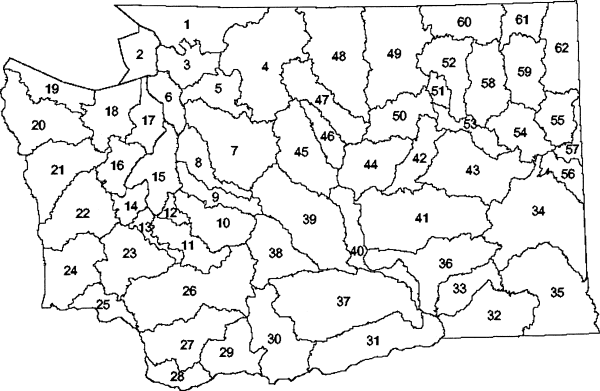 |
| Key: | |||
| 1. Nooksack | 21. Queets/Quinault | 41. Lower Crab | 61. Upper Lake Roosevelt |
| 2. San Juan | 22. Lower Chehalis | 42. Grand Coulee | 62. Pend Oreille |
| 3. Lower Skagit/Samish | 23. Upper Chehalis | 43. Upper Crab/Wilson | |
| 4. Upper Skagit | 24. Willapa | 44. Moses Coulee | |
| 5. Stillaguamish | 25. Grays/Elochoman | 45. Wenatchee | |
| 6. Island | 26. Cowlitz | 46. Entiat | |
| 7. Snohomish | 27. Lewis | 47. Chelan | |
| 8. Cedar/Sammamish | 28. Salmon/Washougal | 48. Methow | |
| 9. Duwamish/Green | 29. Wind/White Salmon | 49. Okanogan | |
| 10. Puyallup/White | 30. Klickitat | 50. Foster | |
| 11. Nisqually | 31. Rock/Glade | 51. Nespelem | |
| 12. Chambers/Clover | 32. Walla Walla | 52. Sanpoil | |
| 13. Deschutes | 33. Lower Snake | 53. Lower Lake Roosevelt | |
| 14. Kennedy/Goldsborough | 34. Palouse | 54. Lower Spokane | |
| 15. Kitsap | 35. Middle Snake | 55. Little Spokane | |
| 16. Skokomish/ Dosewallips |
36. Esquatzel Coulee | 56. Hangman | |
| 17. Quilcene/Snow | 37. Lower Yakima | 57. Middle Spokane | |
| 18. Elwha/Dungeness | 38. Naches | 58. Middle Lake Roosevelt | |
| 19. Lyre/Hoko | 39. Upper Yakima | 59. Colville | |
| 20. Soleduck/Hoh | 40. Alkaki/Squilchuck | 60. Kettle | |
| (( |
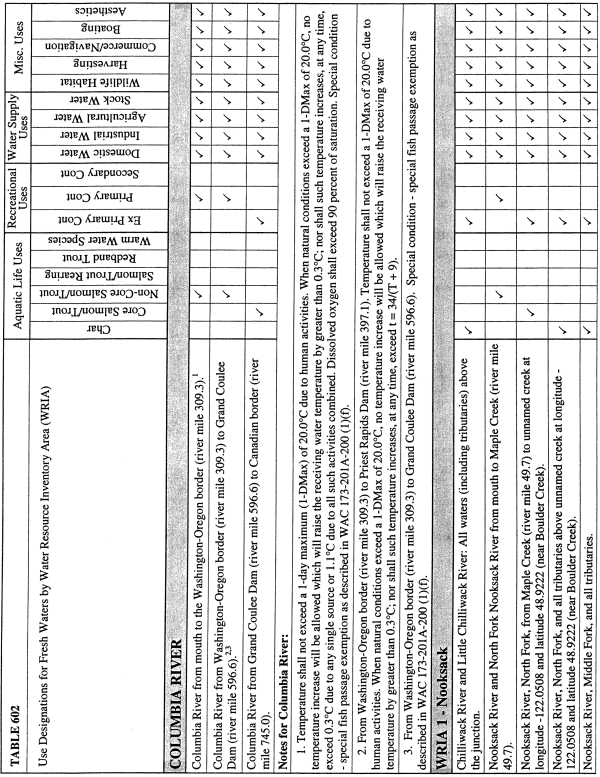 |
| (( |
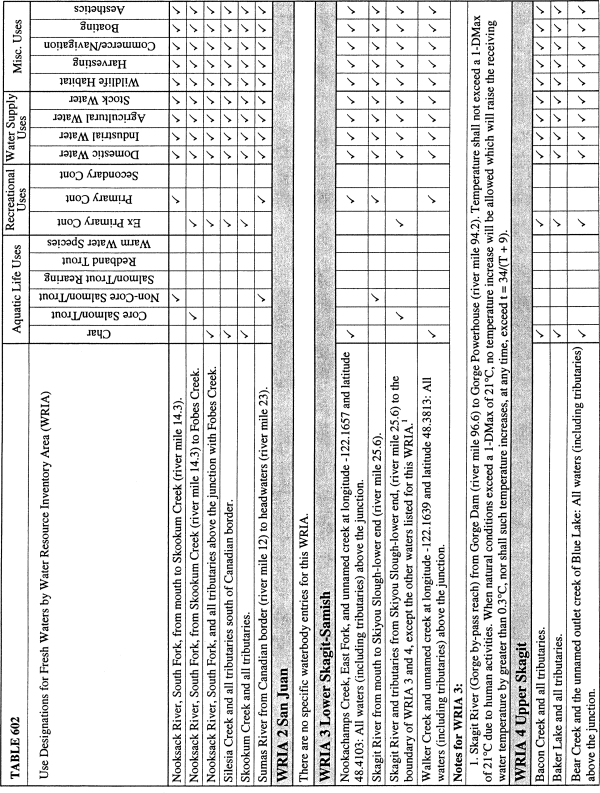 |
| (( |
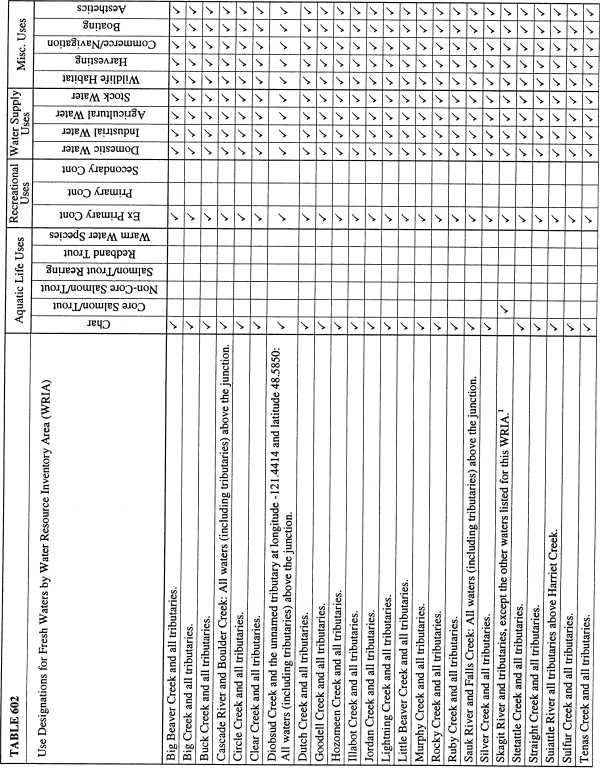 |
| (( |
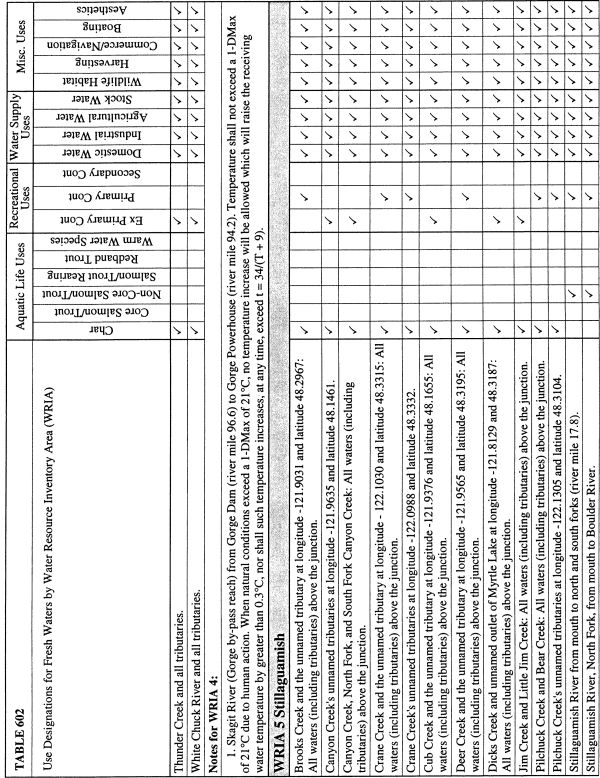 |
| (( |
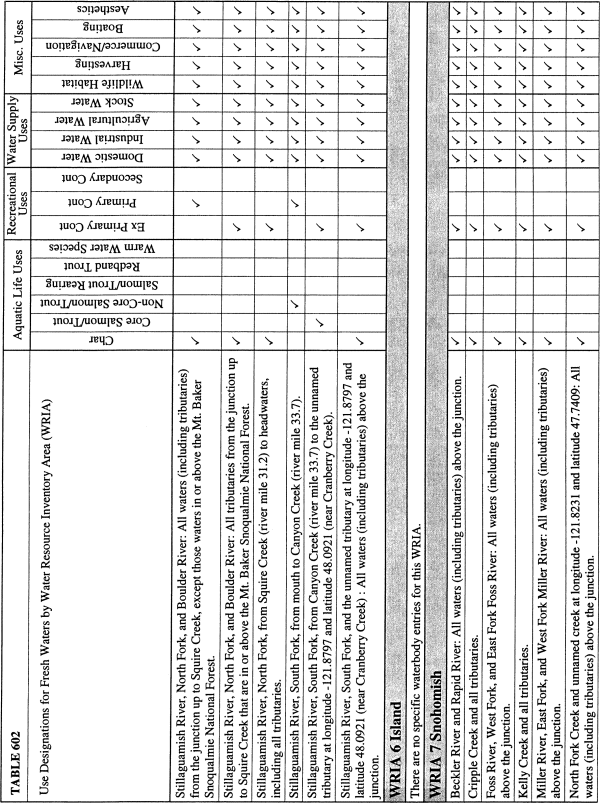 |
| (( |
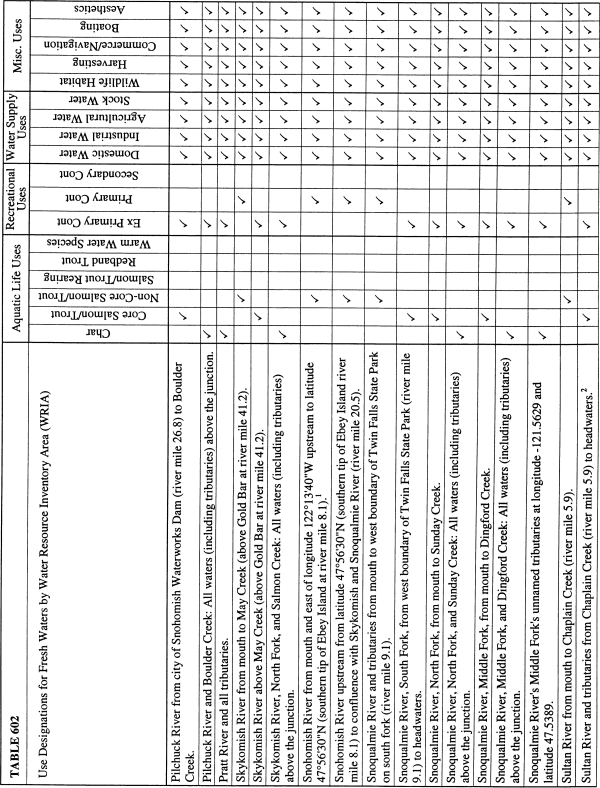 |
| (( |
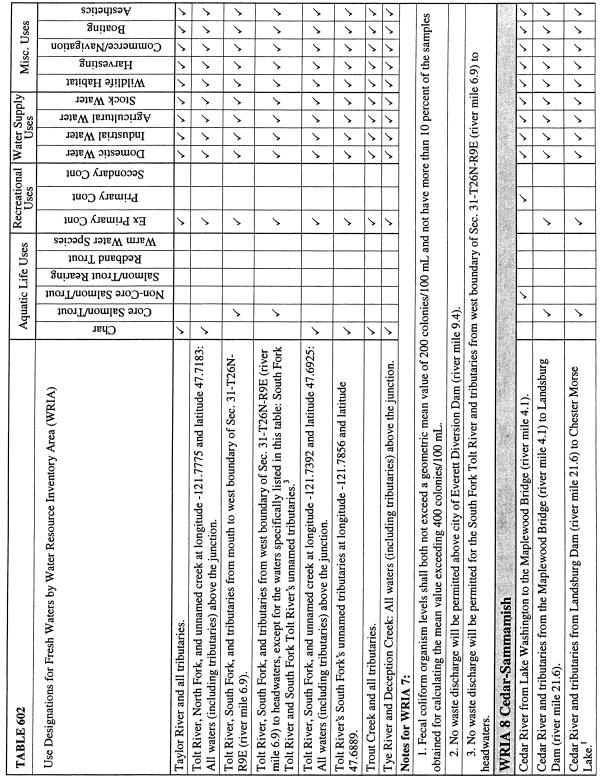 |
| (( |
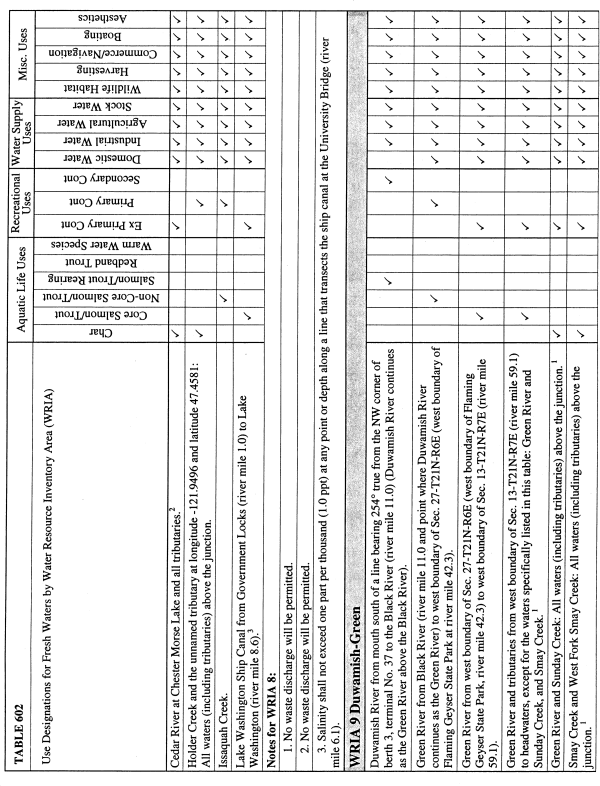 |
| (( |
 |
| (( |
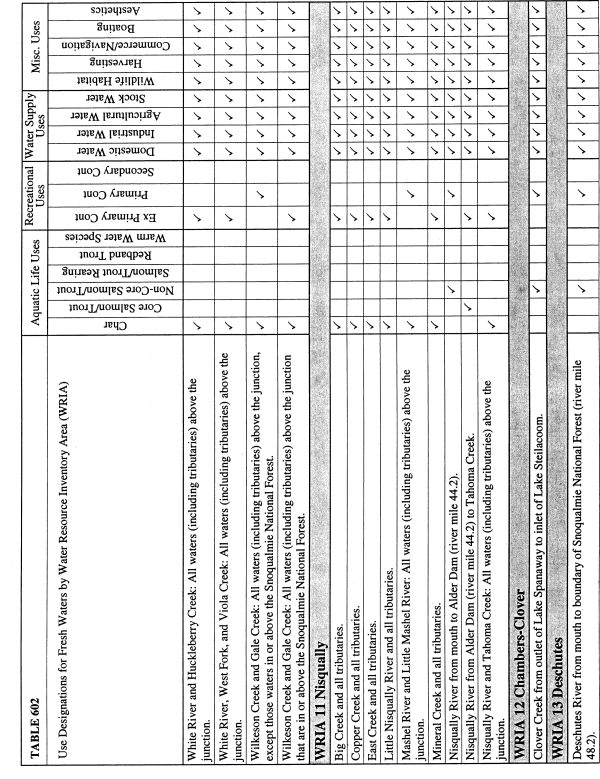 |
| (( |
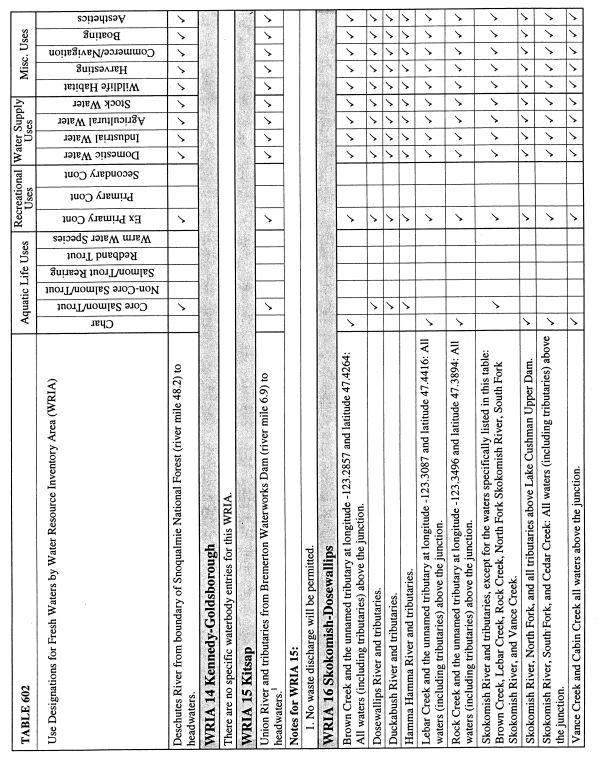 |
| (( |
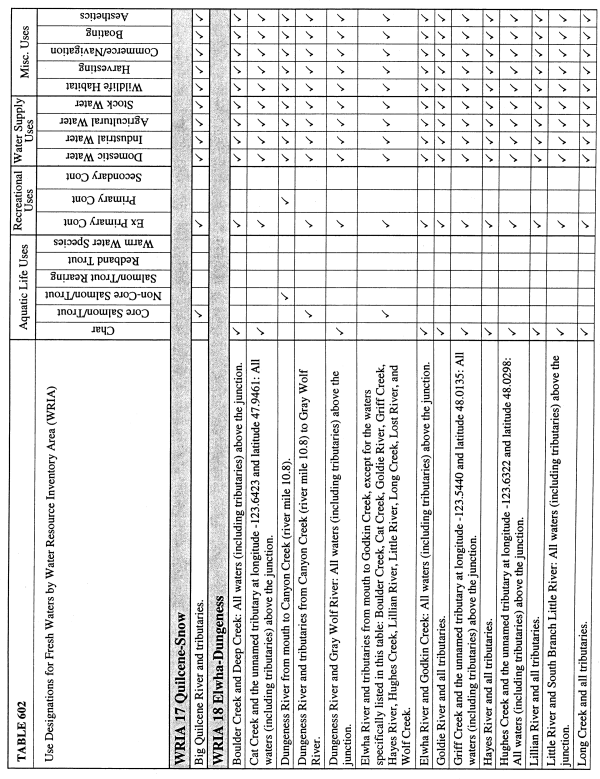 |
| (( |
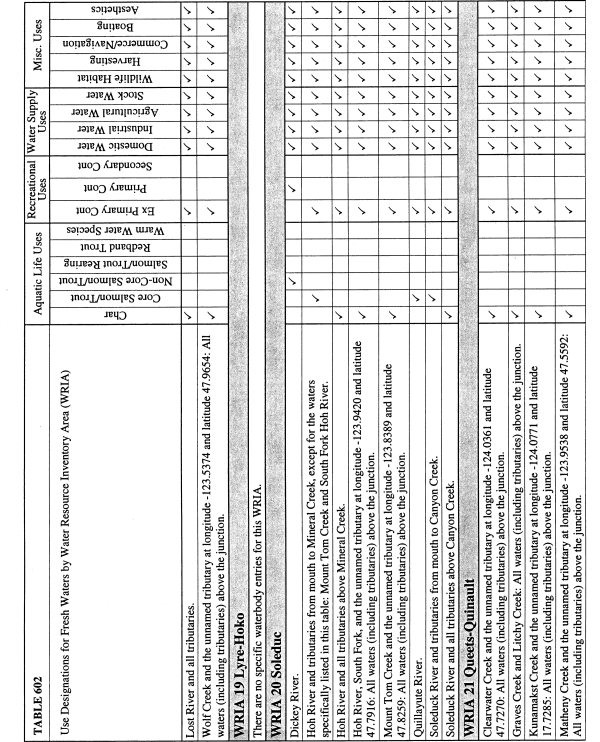 |
| (( |
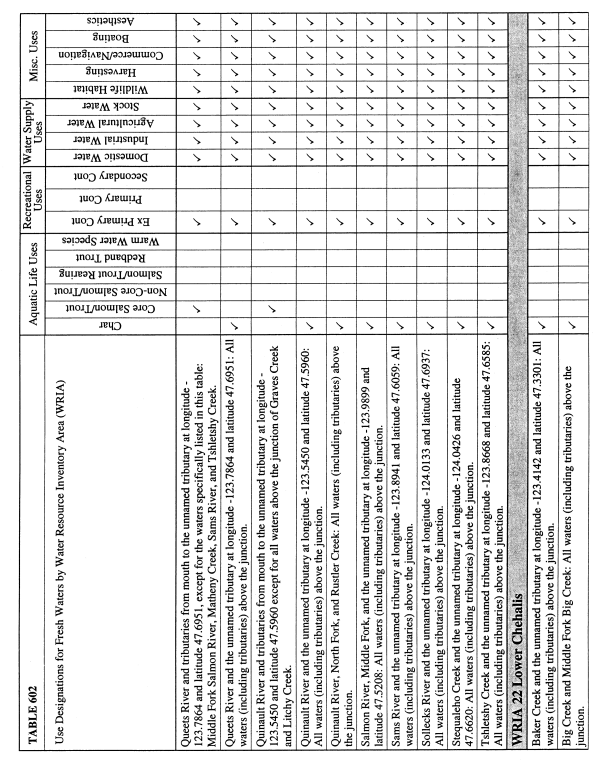 |
| (( |
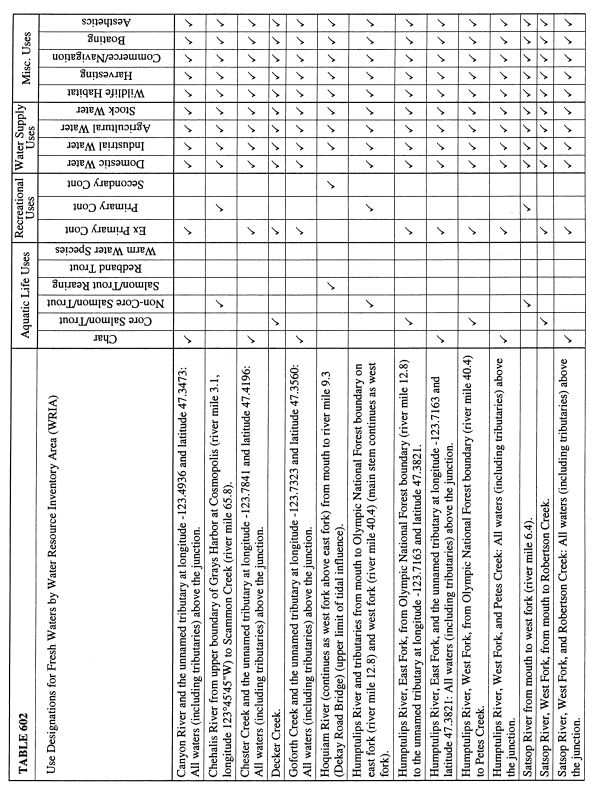 |
| (( |
 |
| (( |
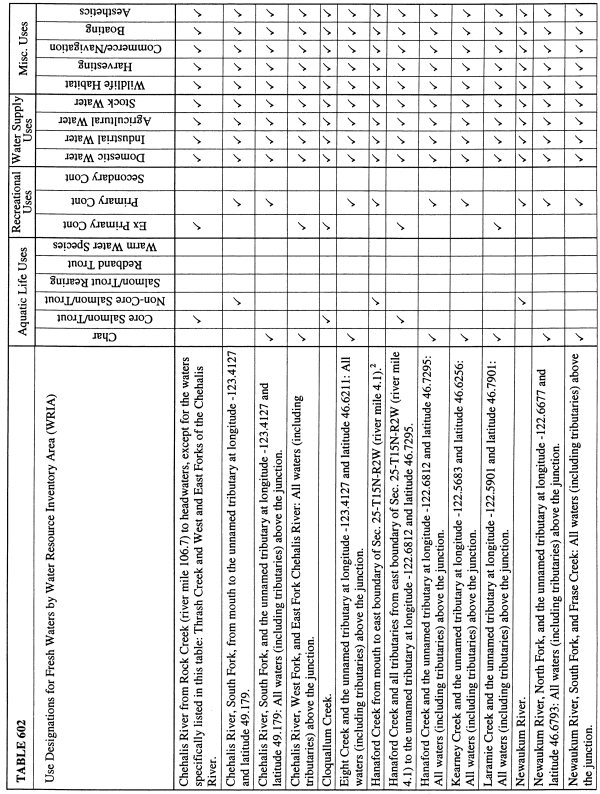 |
| (( |
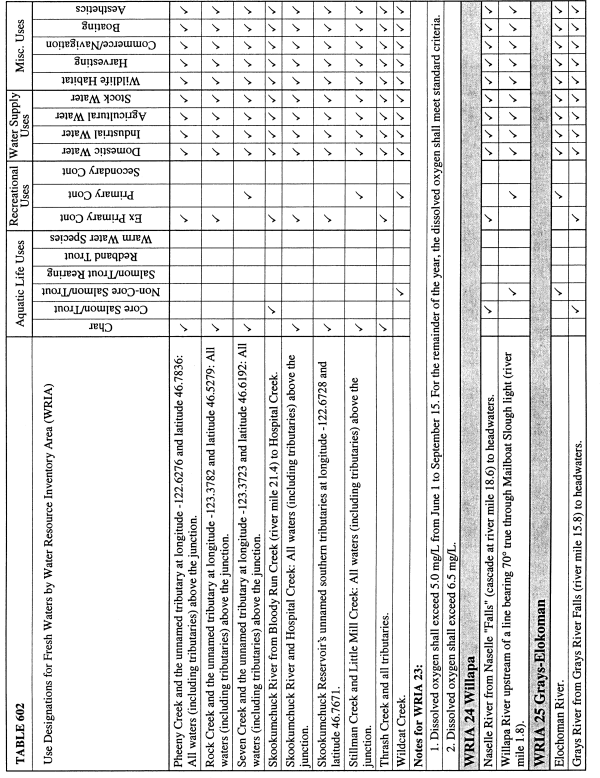 |
| (( |
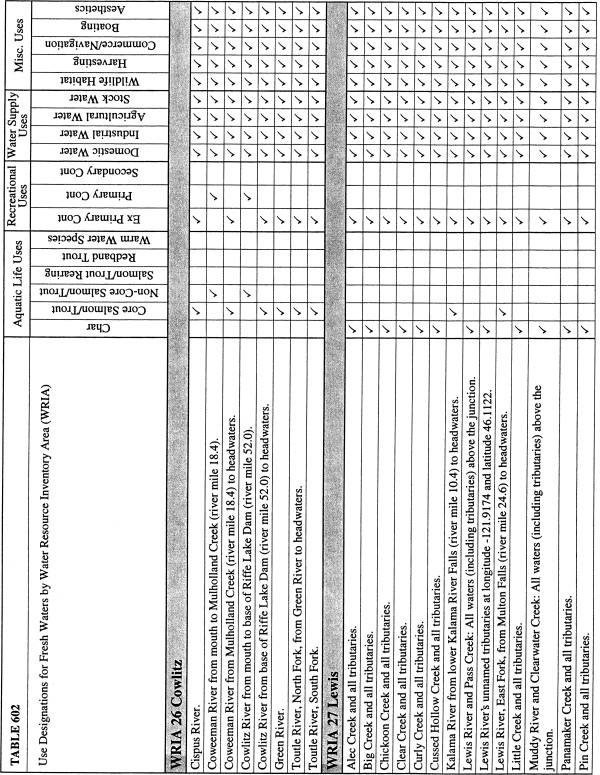 |
| (( |
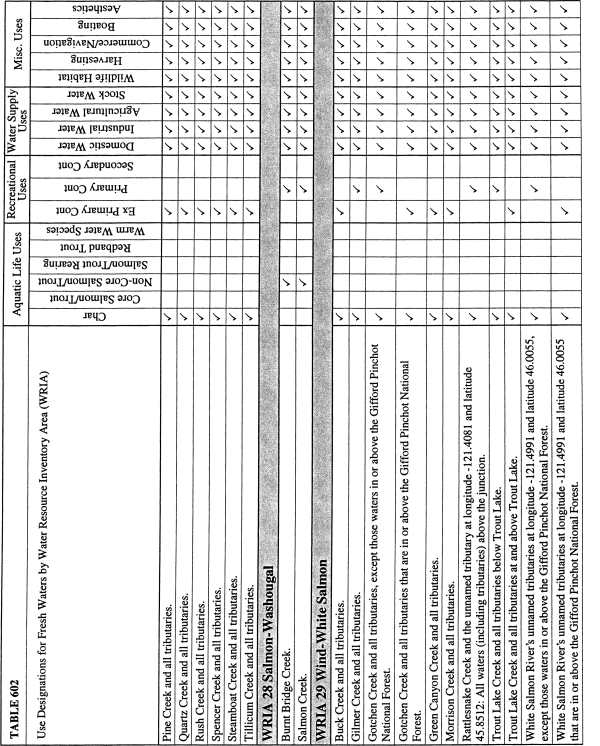 |
| (( |
 |
| (( |
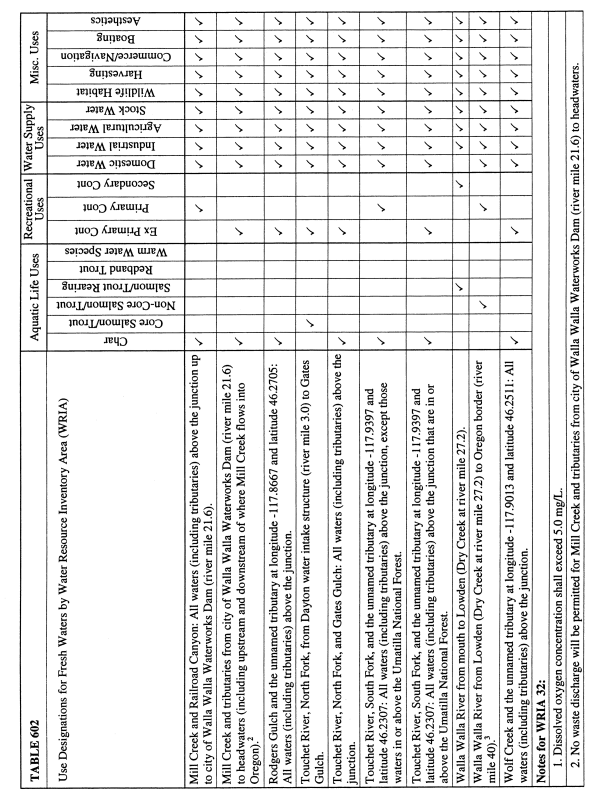 |
| (( |
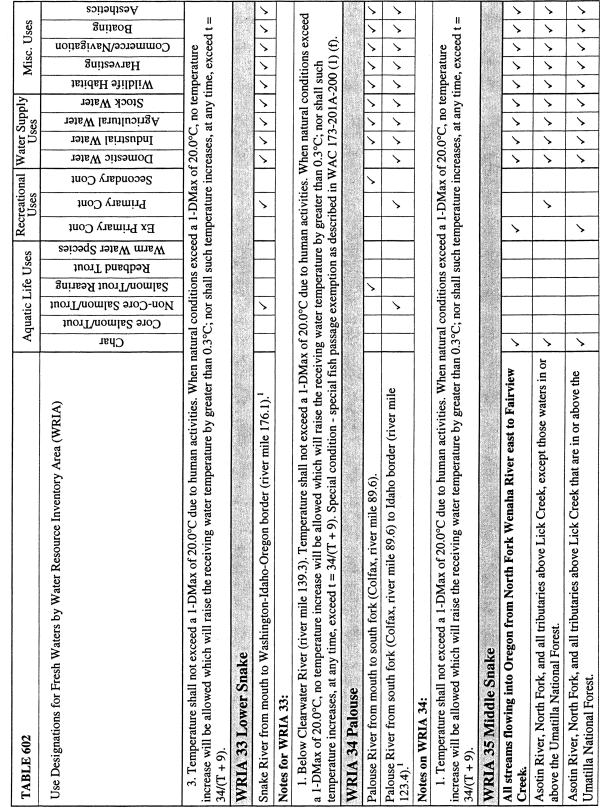 |
| (( |
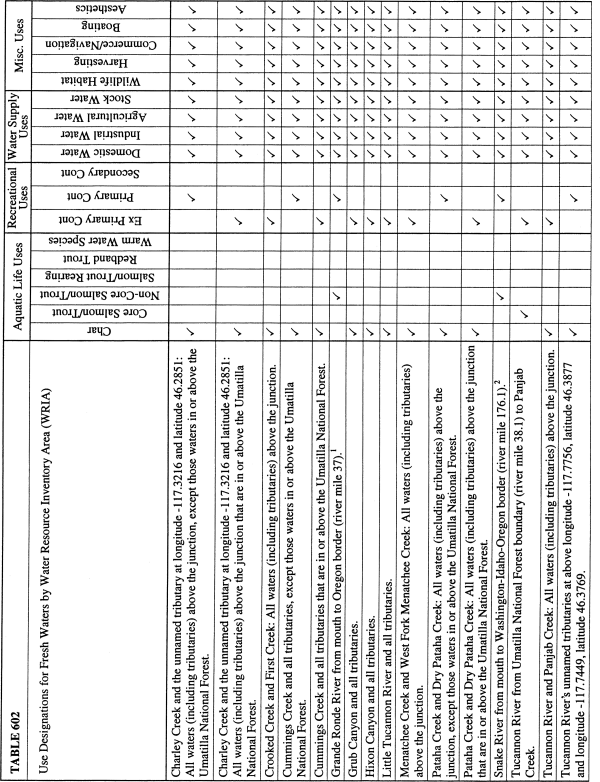 |
| (( |
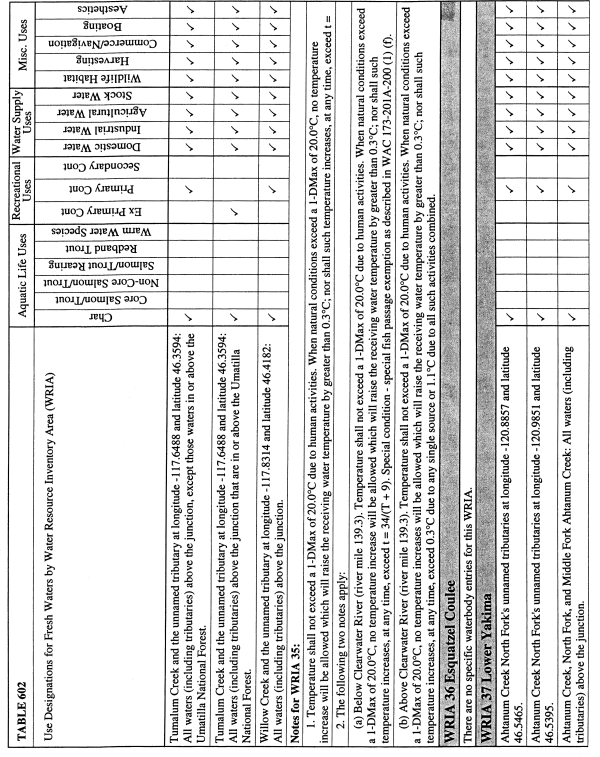 |
| (( |
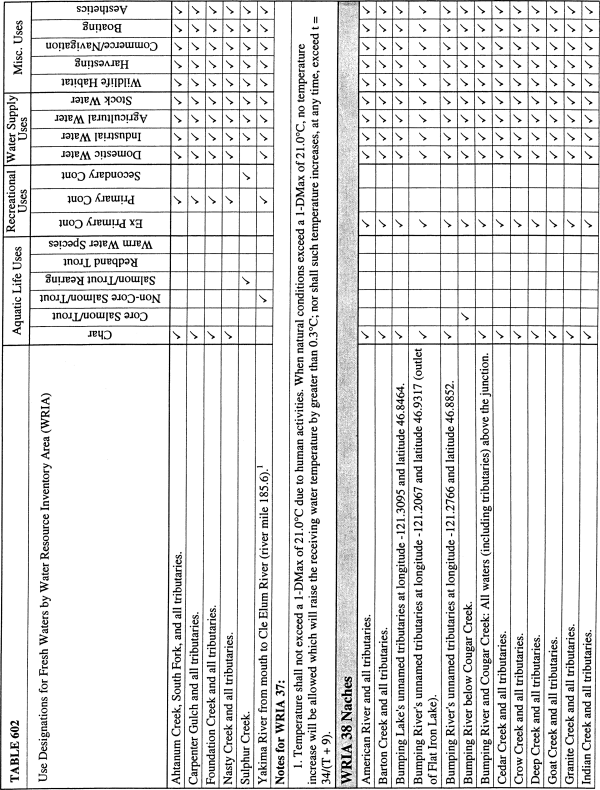 |
| (( |
 |
| (( |
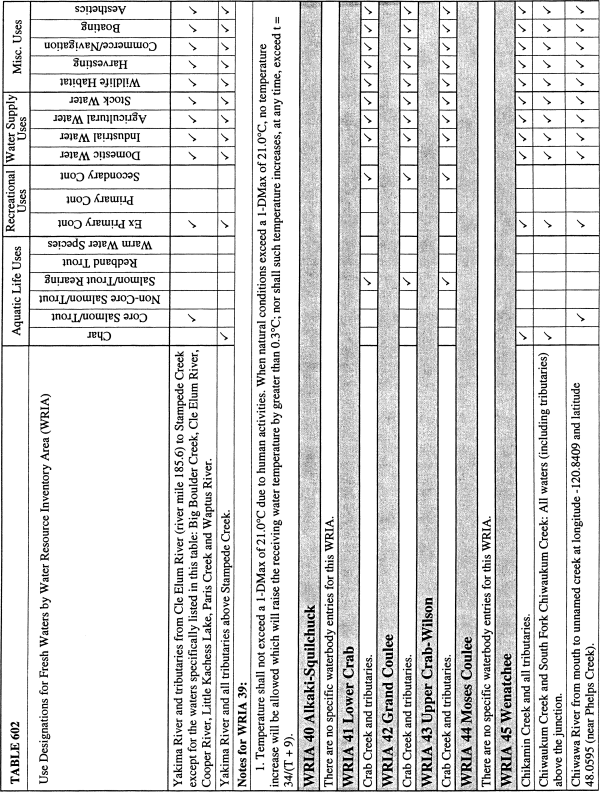 |
| (( |
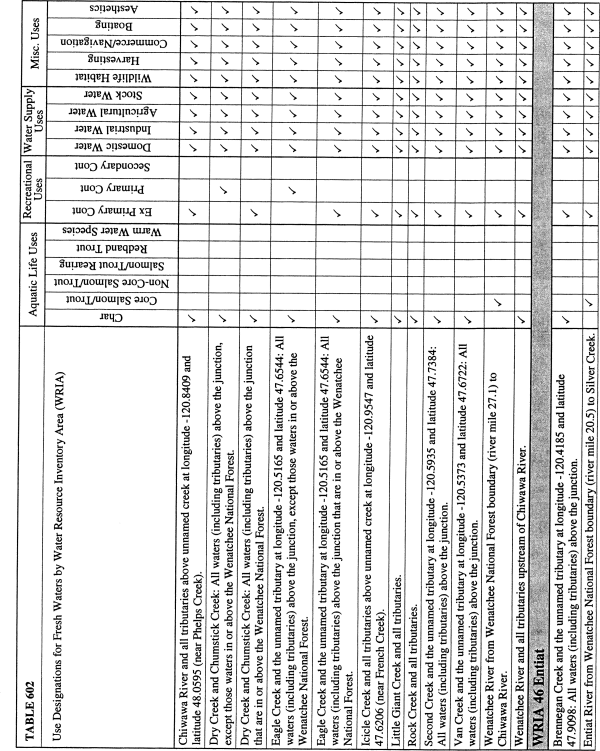 |
| (( |
 |
| (( |
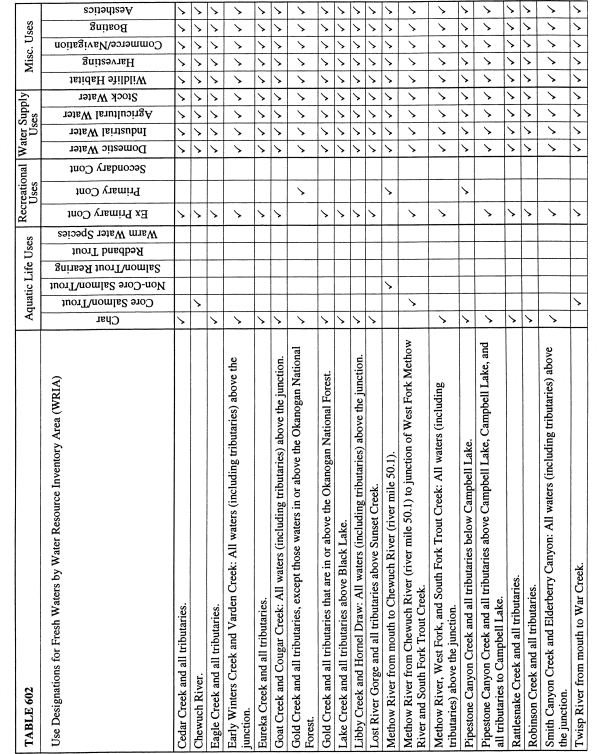 |
| (( |
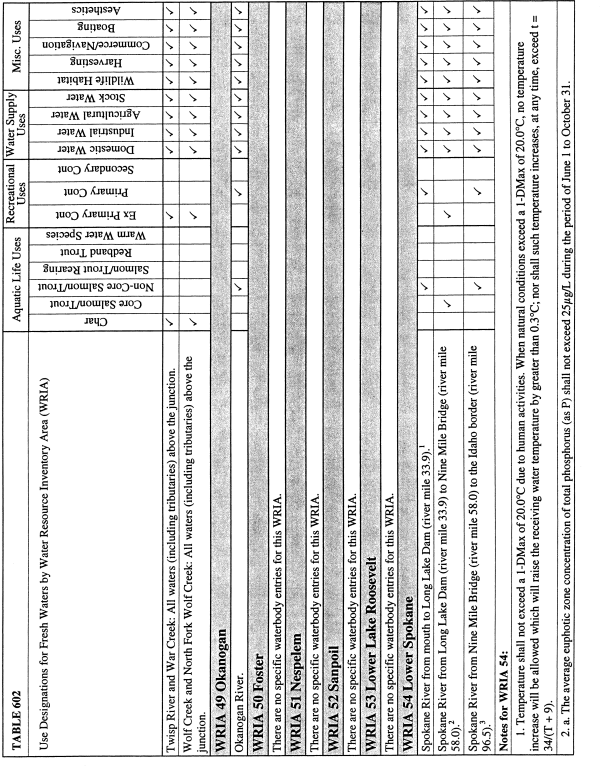 |
| (( |
 |
| (( |
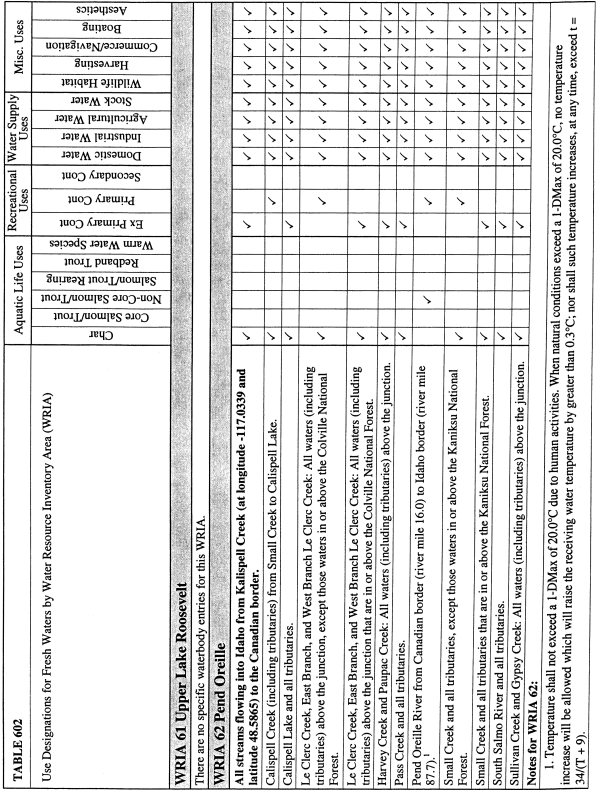 |
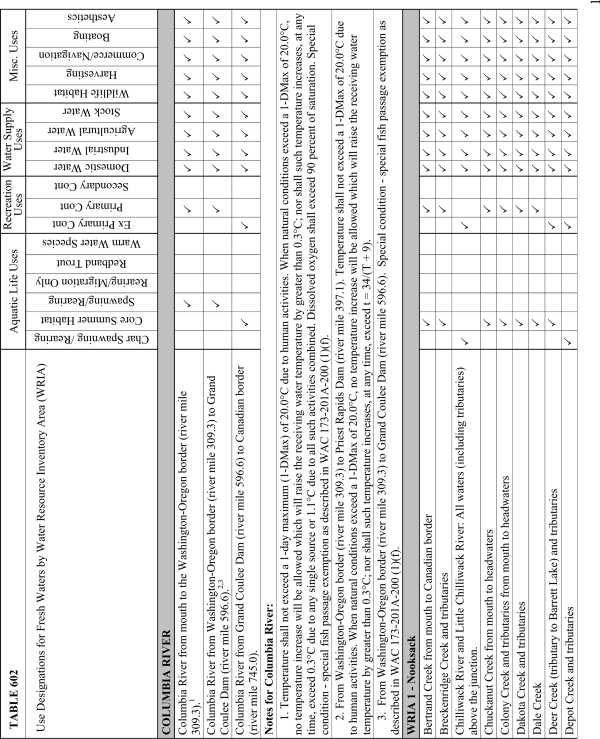
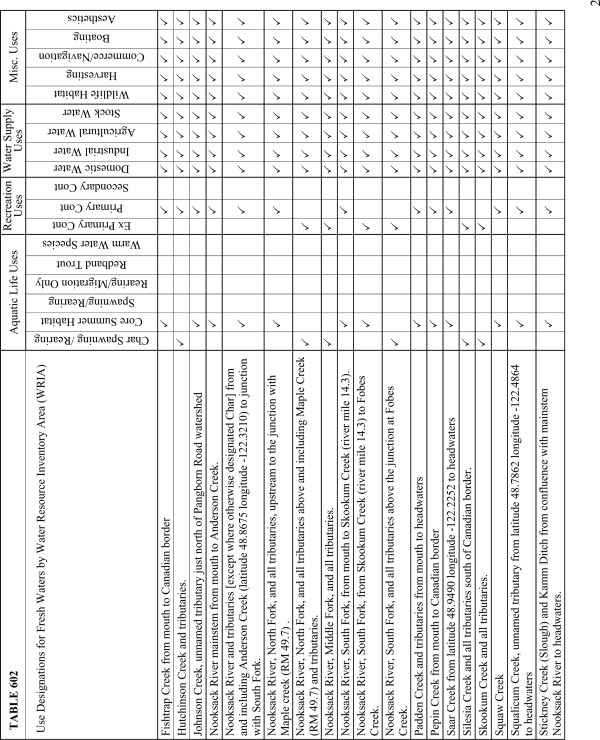
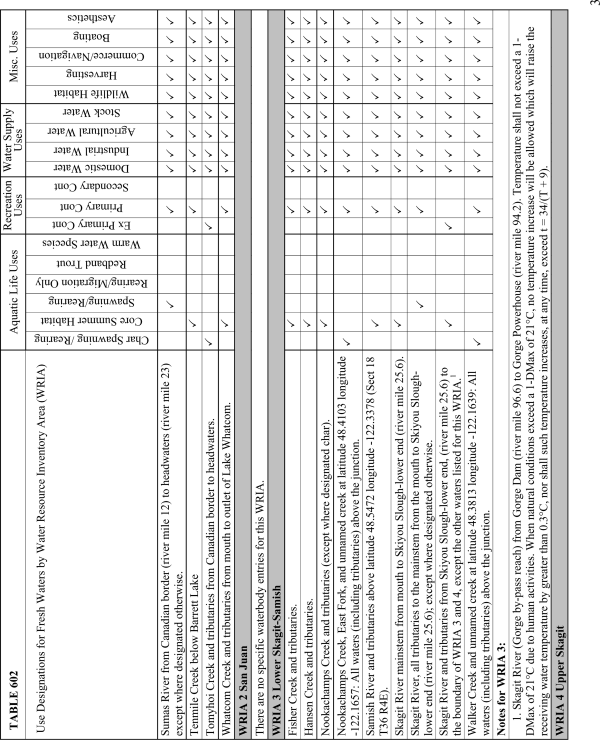
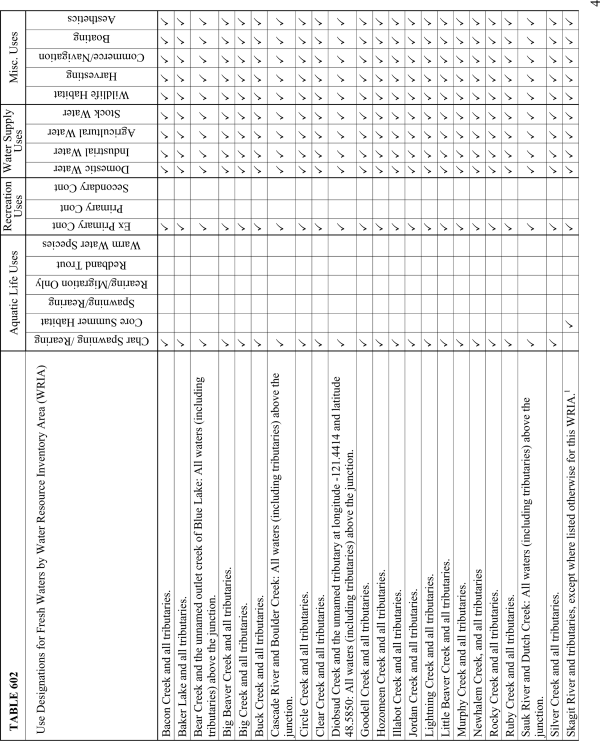
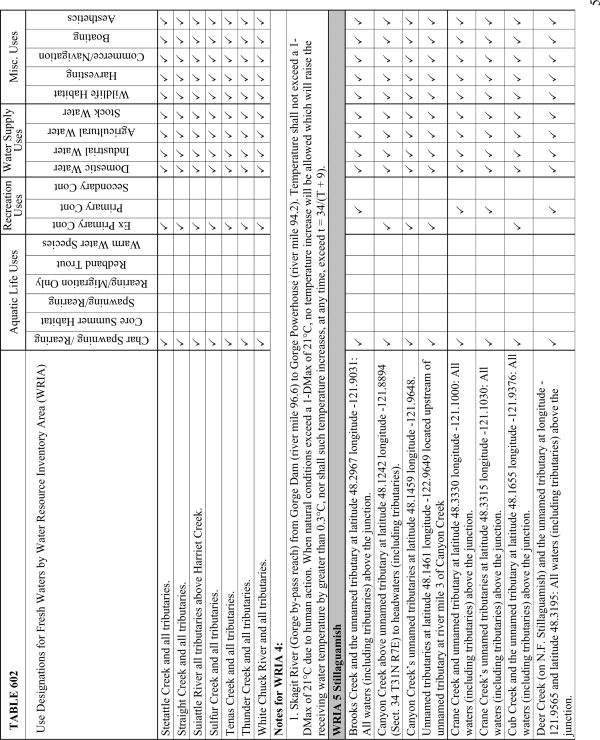

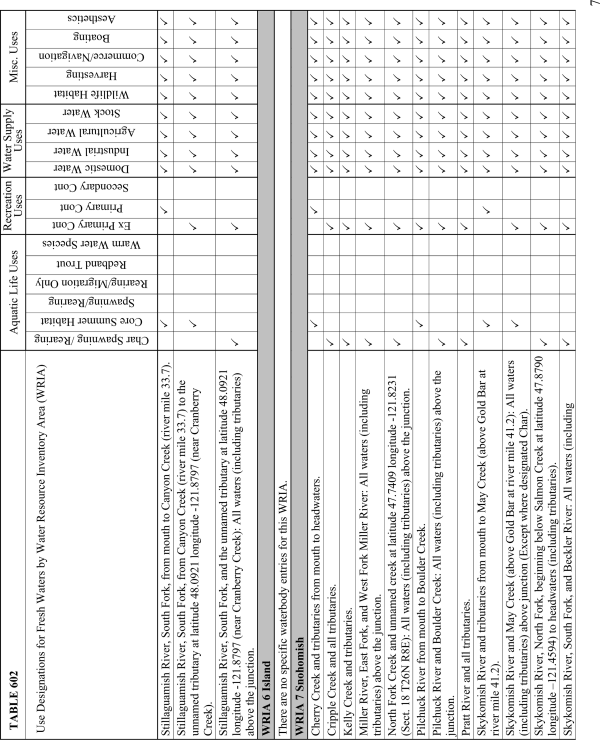
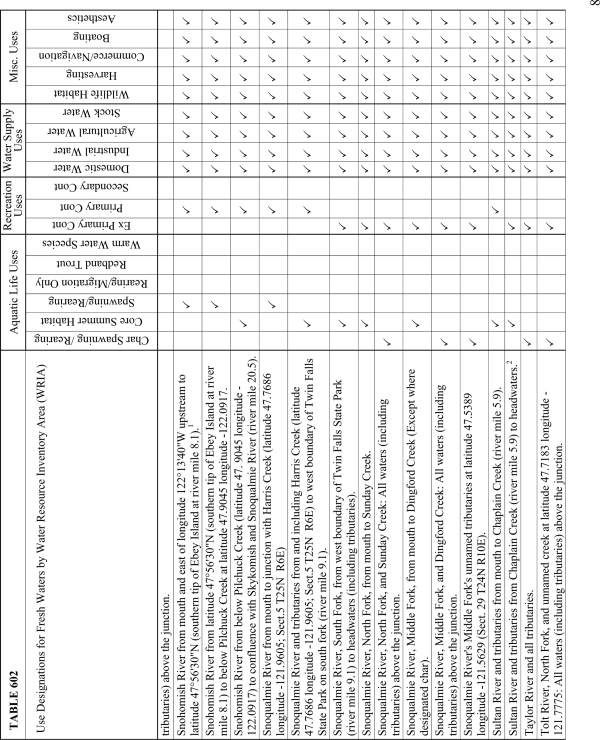
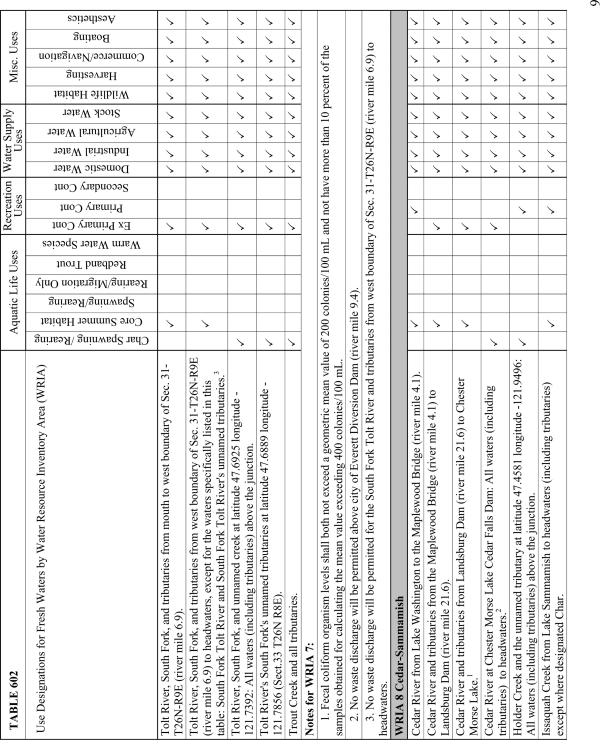
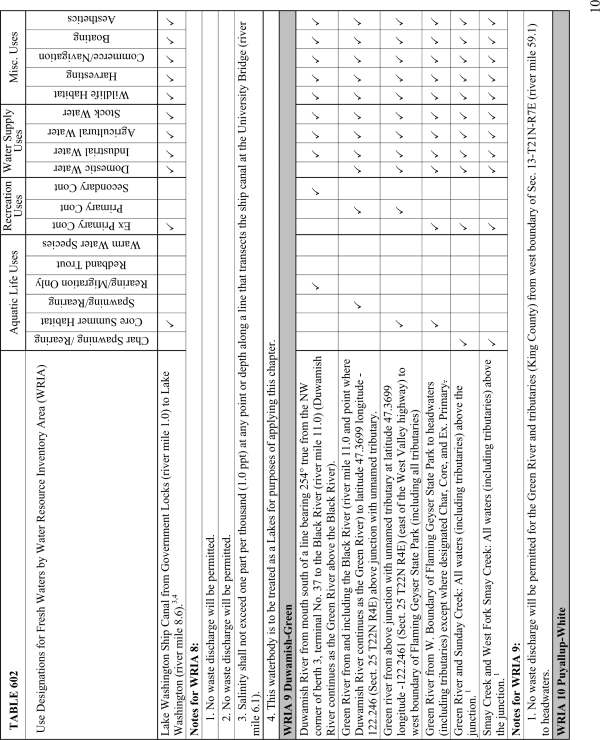
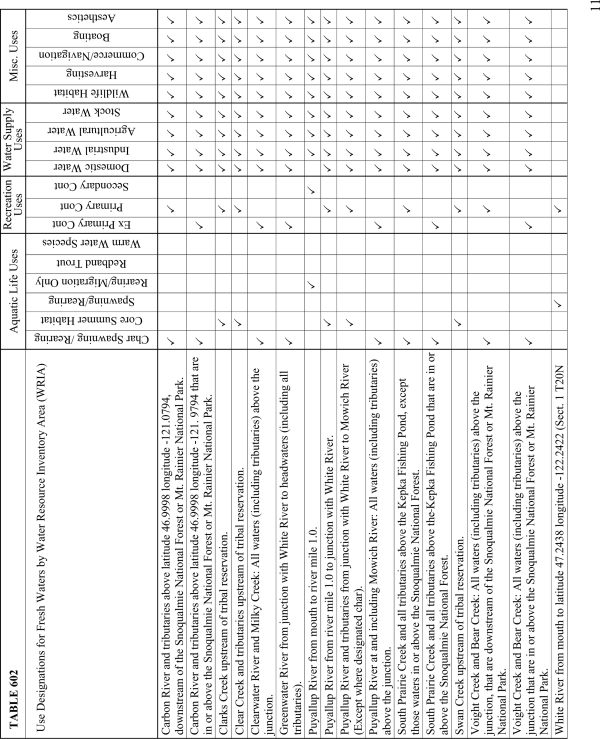
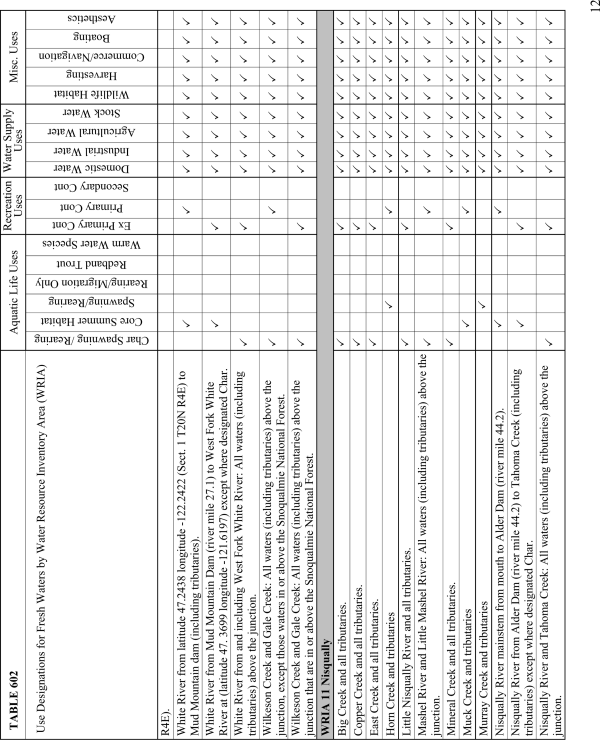

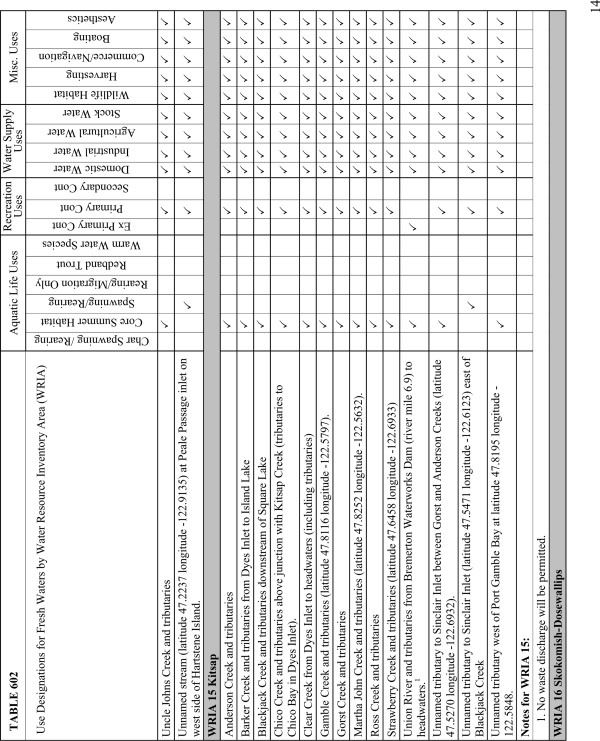
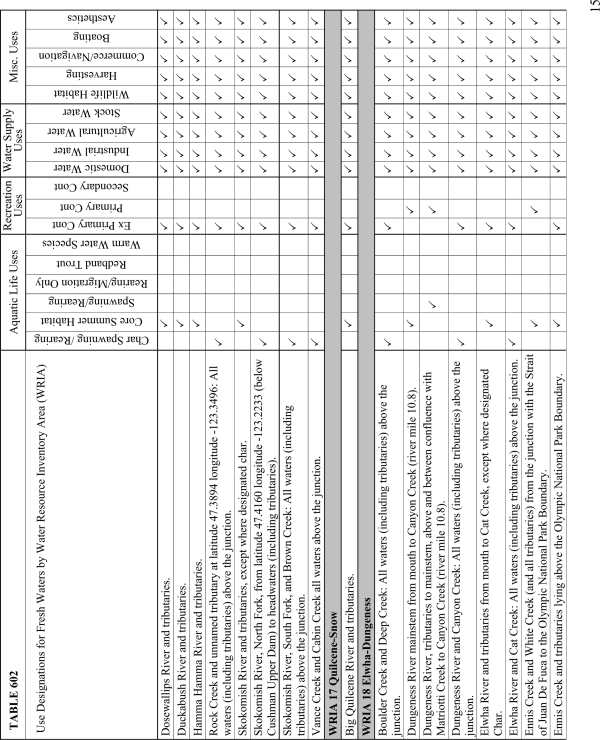
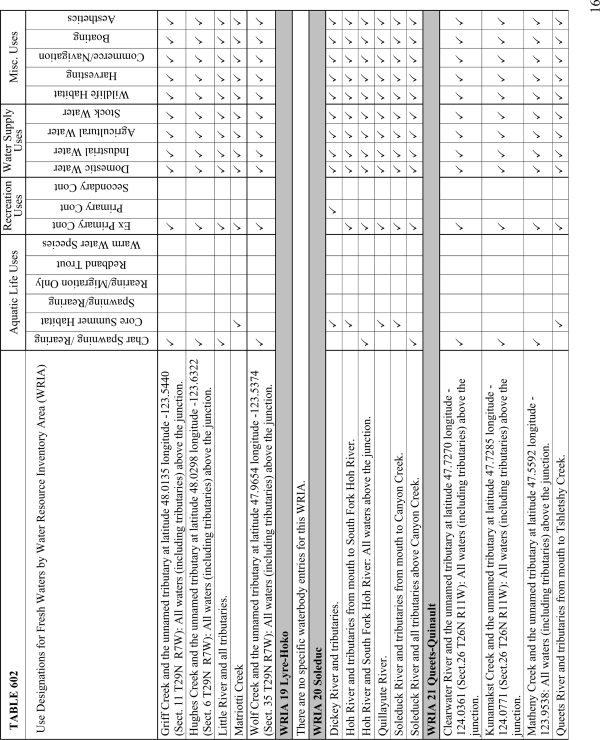

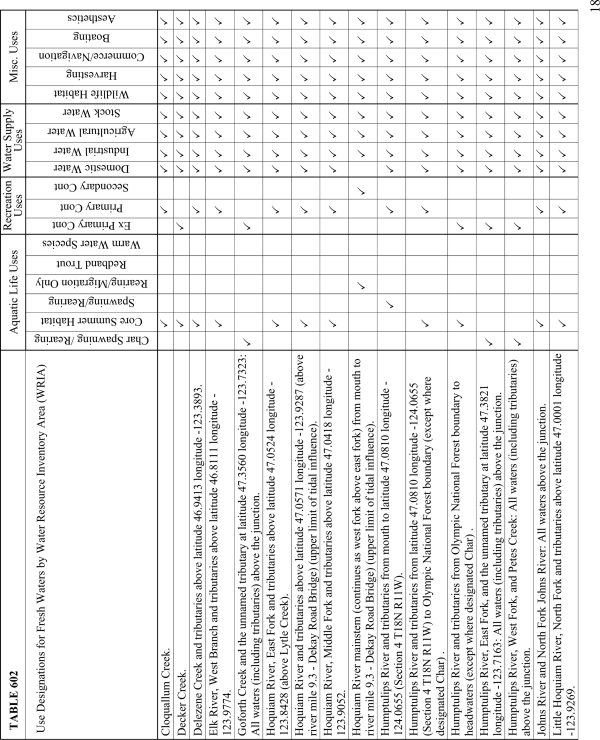
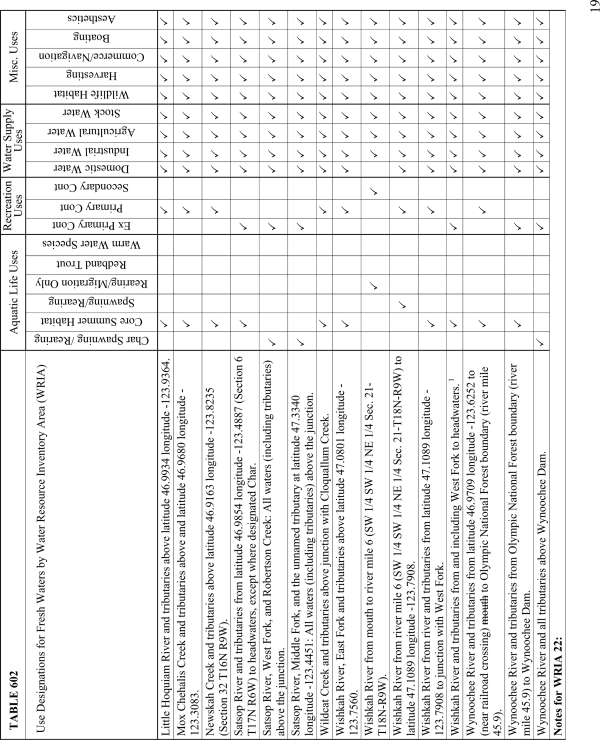
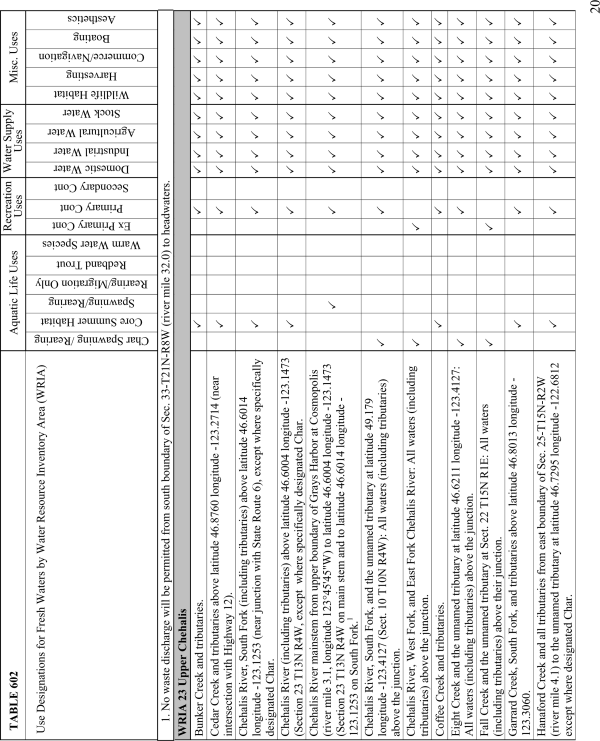
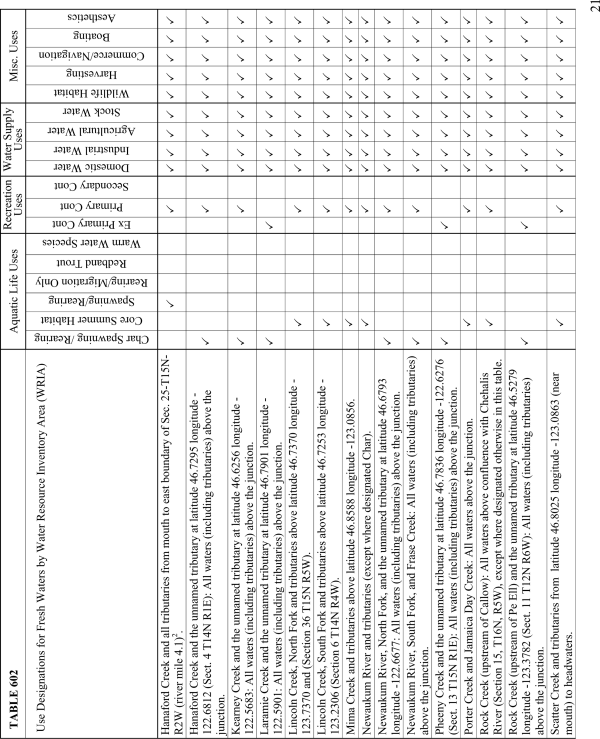
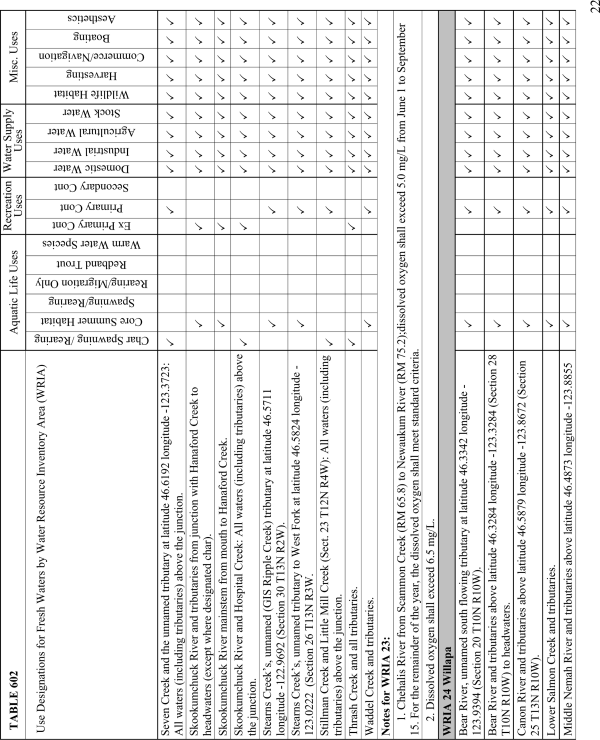
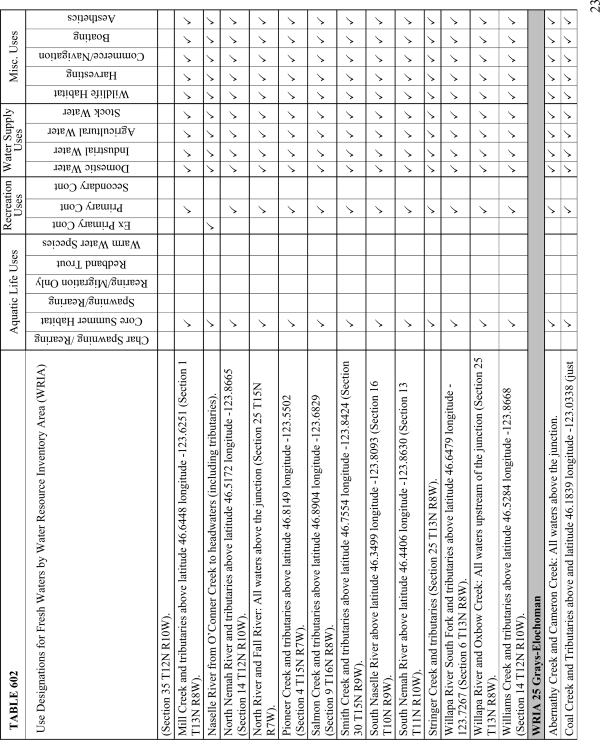
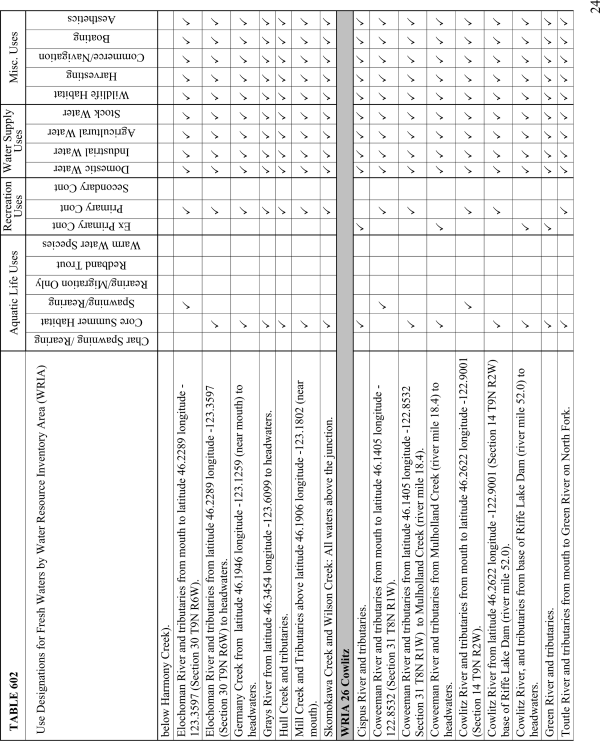

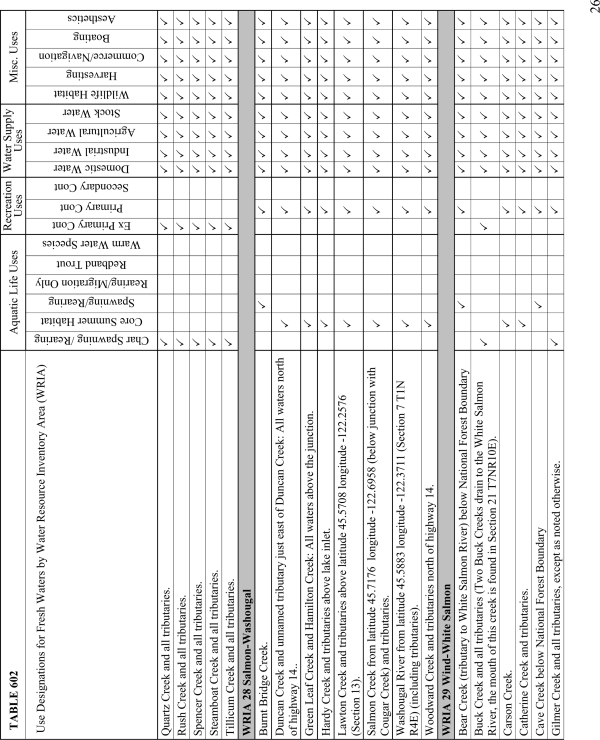

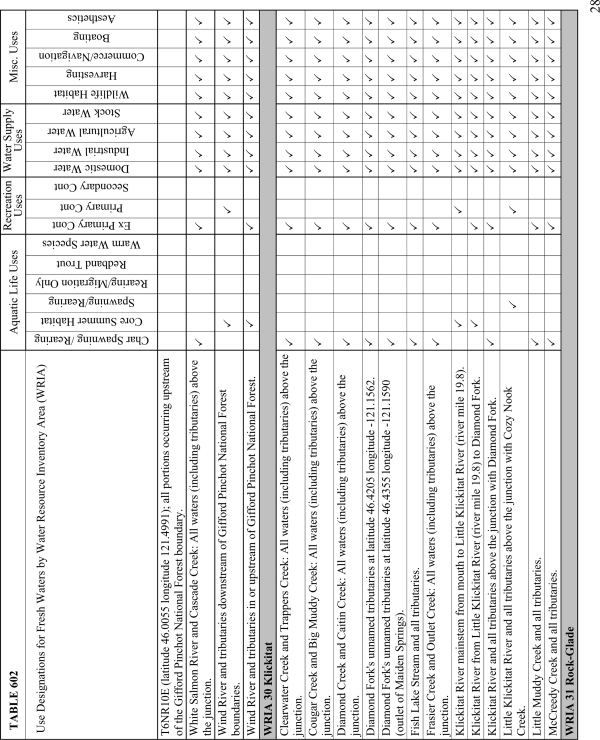
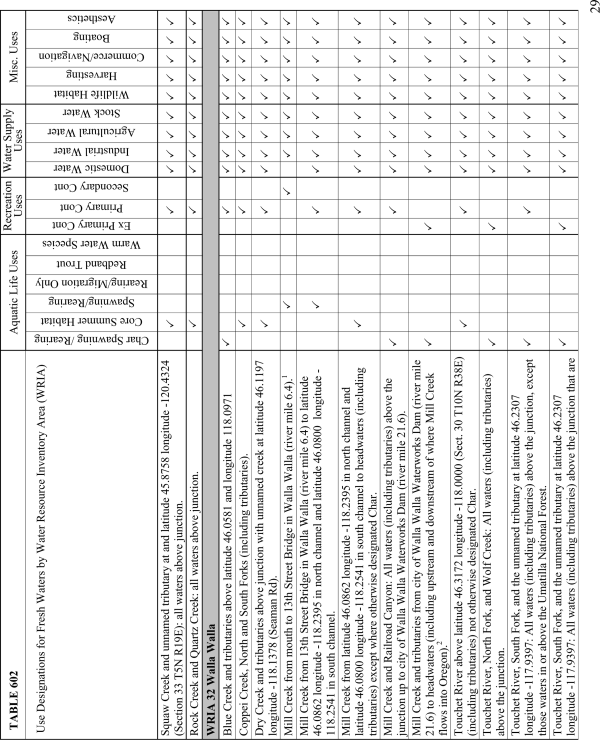
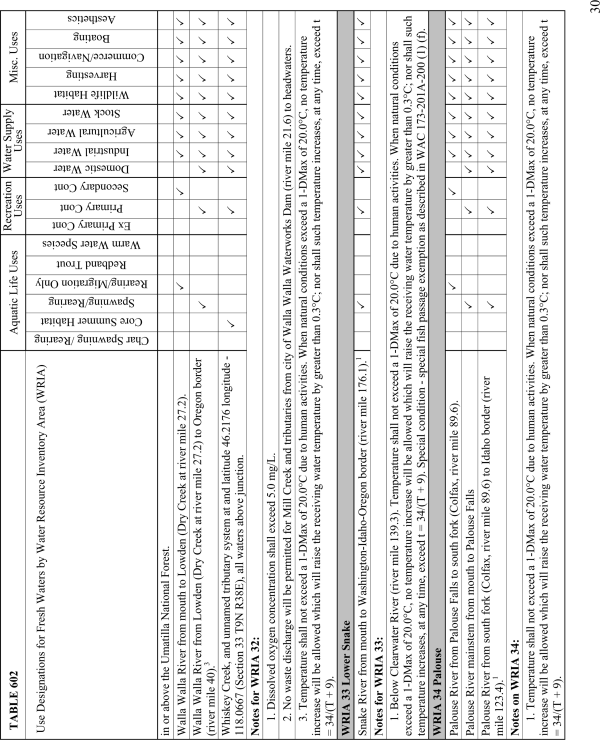

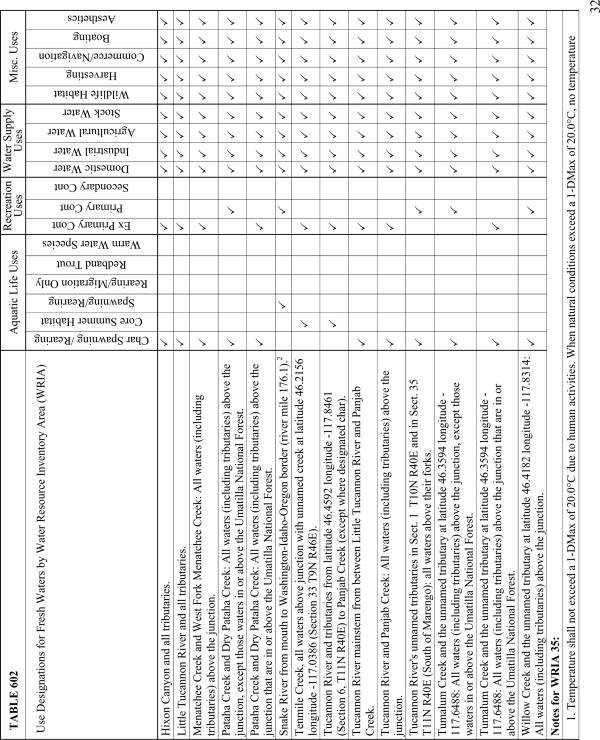

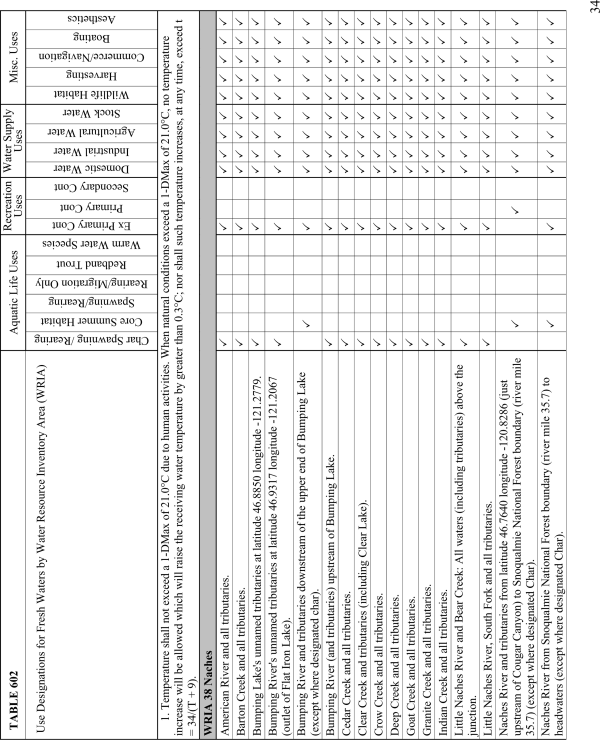
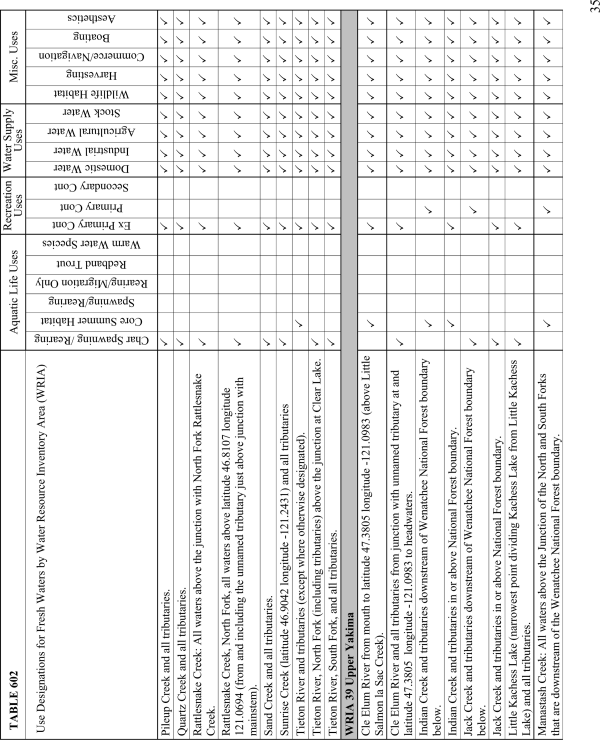


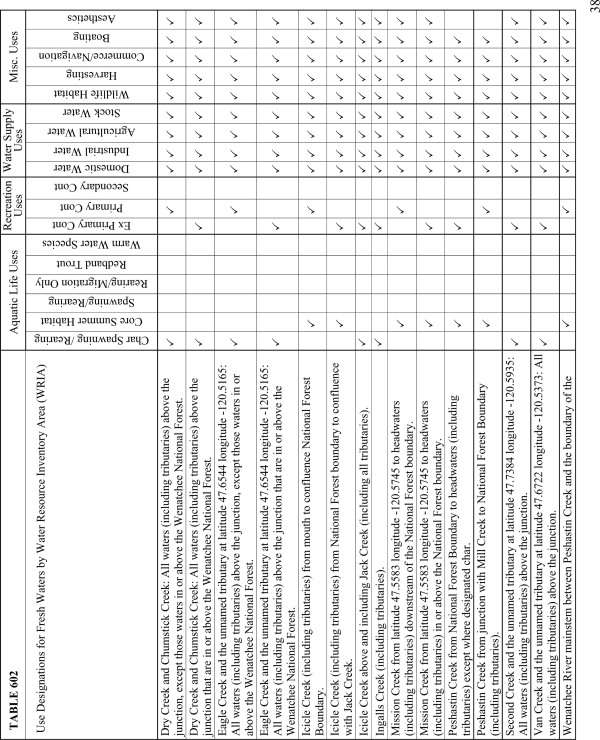

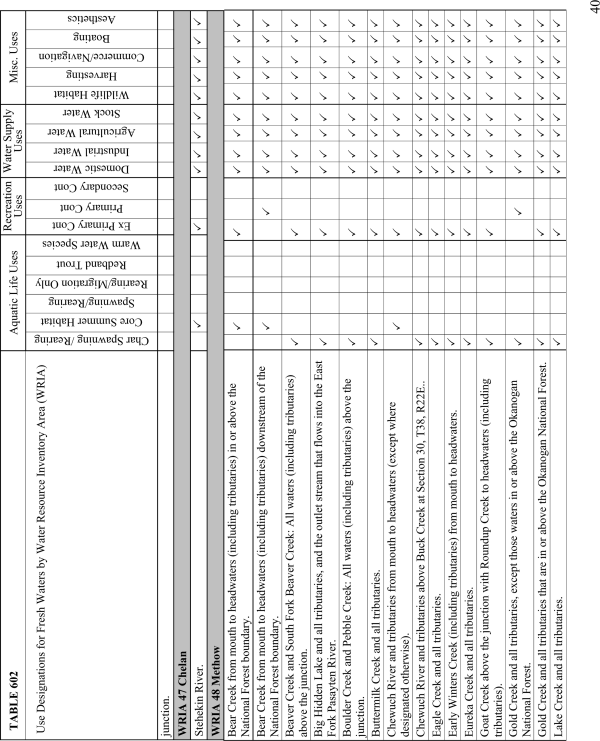
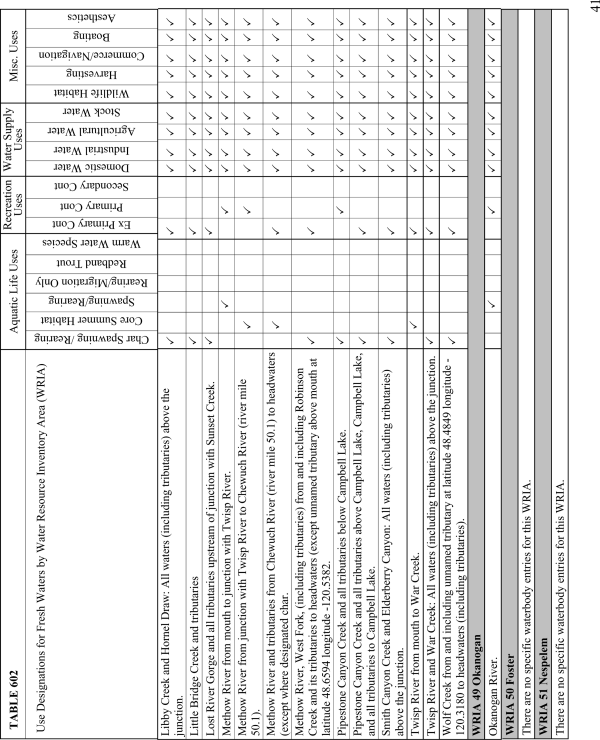




[Statutory Authority: Chapters 90.48 and 90.54 RCW. 03-14-129 (Order 02-14), § 173-201A-602, filed 7/1/03, effective 8/1/03.]